
The remarkable twin Voyager spacecraft continue to explore the outer reaches of the solar system decades after they completed their surveys of the Outer Planets. Launched in 1977 (September 5 for Voyager 1 (V1) and August 20 for Voyager 2 (V2), whose trajectory took it past Jupiter after Voyager 1), the spacecraft pair made many fundamental discoveries as they flew past Jupiter (March 1979 for V1, July 1979 for V2) and Saturn (November 1980 for V1, August 1981 for V2). The path of Voyager 2 past Saturn was targeted so that it continued within the plane of the solar system, allowing it to become the first spacecraft to visit Uranus (January 1986) and Neptune (August 1989). Following the Neptune encounter, both spacecraft started a new phase of exploration under the intriguing title of the Voyager Interstellar Mission.
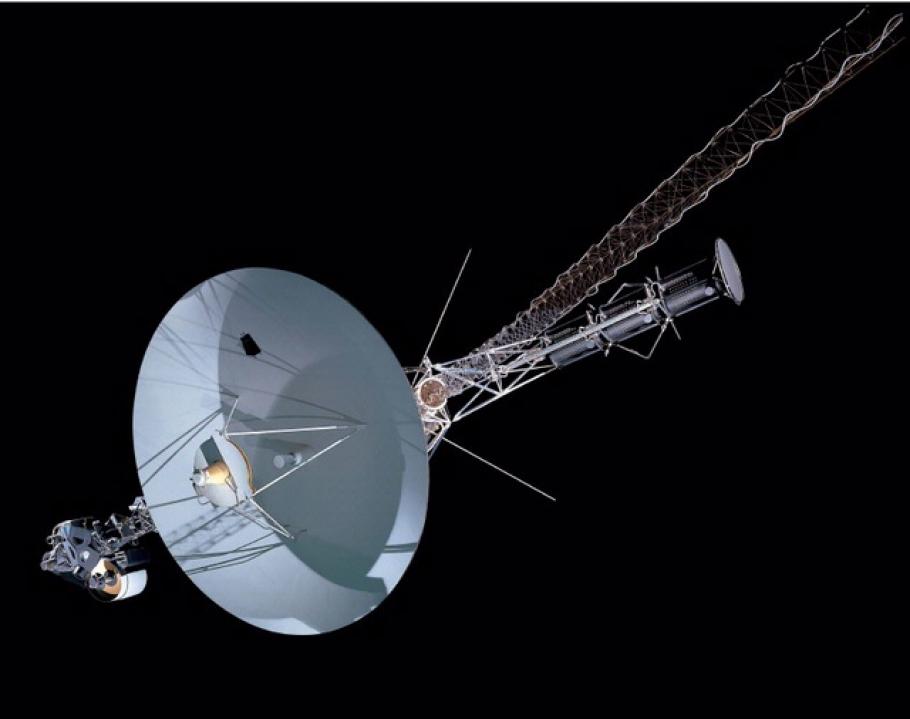
Five instruments continue to collect important measurements of magnetic fields, plasmas, and charged particles as both spacecraft explore different portions of the solar system beyond the orbits of the planets. Voyager 1 is now more than 118 astronomical units (one AU is equal to the average orbital distance of Earth from the Sun) distant from the sun, traveling at a speed (relative to the sun) of 17.1 kilometers per second (10.6 miles per second). Voyager 2 is now more than 96 AU from the sun, traveling at a speed of 15.5 kilometers per second (9.6 miles per second). Both spacecraft are moving considerably faster than Pioneers 10 and 11, two earlier spacecraft that became the first robotic visitors to fly past Jupiter and Saturn in the mid-70s.
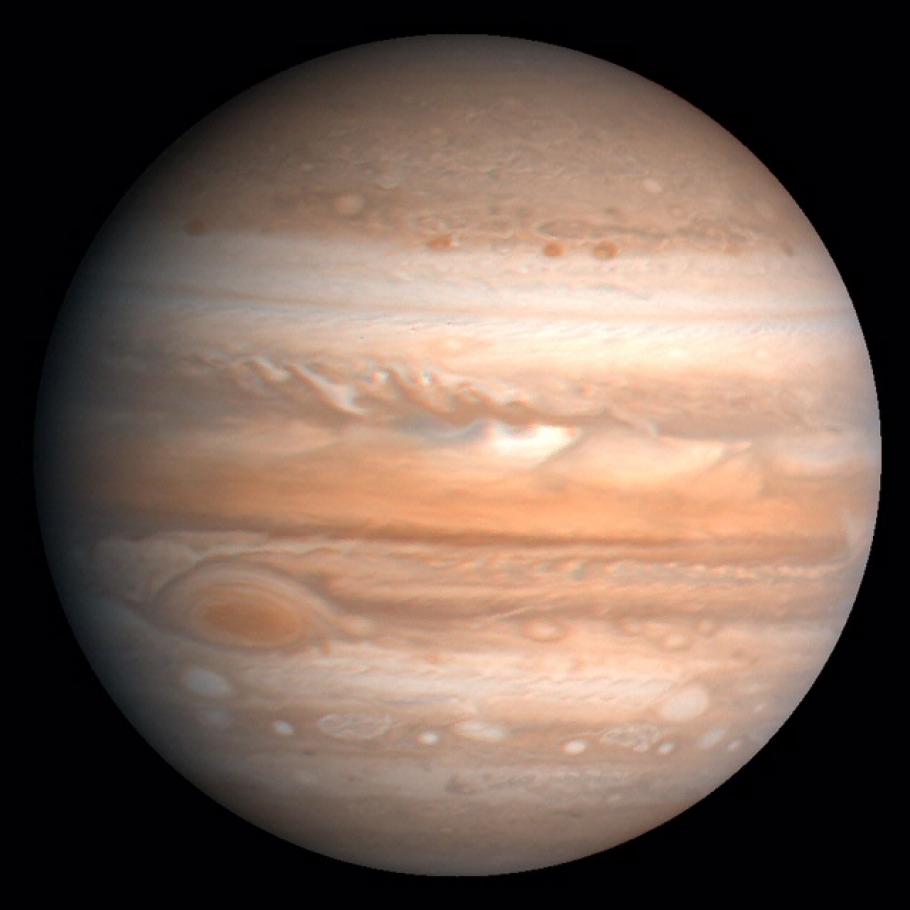
This processed color image of Jupiter was produced in 1990 by the U.S. Geological Survey from a Voyager image captured in 1979. The colors have been enhanced to bring out detail. Zones of light-colored, ascending clouds alternate with bands of dark, descending clouds. The clouds travel around the planet in alternating eastward and westward belts at speeds of up to 540 kilometers per hour. Tremendous storms as big as Earthly continents surge around the planet. The Great Red Spot (oval shape toward the lower-left) is an enormous anticyclonic storm that drifts along its belt, eventually circling the entire planet.
As seen in the night sky at Earth, Voyager 1 is within the confines of the constellation Ophiuchus, only slightly above the celestial equator; no telescope can see it, but radio contact is expected to be maintained for at least the next ten years. Voyager 2 is within the bounds of the constellation Telescopium (which somehow sounds quite appropriate) in the far southern night sky.
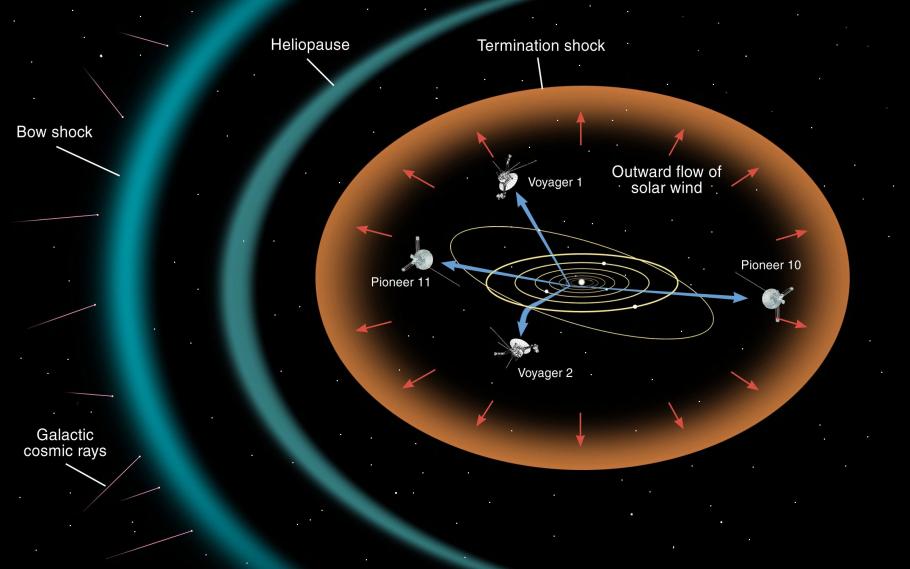
Both spacecraft have already passed something called the Termination Shock † (December 2004 for V1, August 2007 for V2), where the solar wind slows as it starts to interact with the particles and fields present between the stars. It is expected that both spacecraft will encounter the Heliopause, where the solar wind ceases as true interstellar space begins, from 10 to 20 years after crossing the Termination Shock. Theories exist for what should be present in interstellar space, but the Voyagers will become the first man-made objects to go beyond the influences of the Sun, hopefully returning the first measurements of what it is like out there. Each spacecraft is carrying a metal record with encoded sounds and sights from Earth, along with the needle needed to read the recordings, and simplified instructions for where the spacecraft came from, in case they are eventually discovered by intelligent extra-terrestrials.
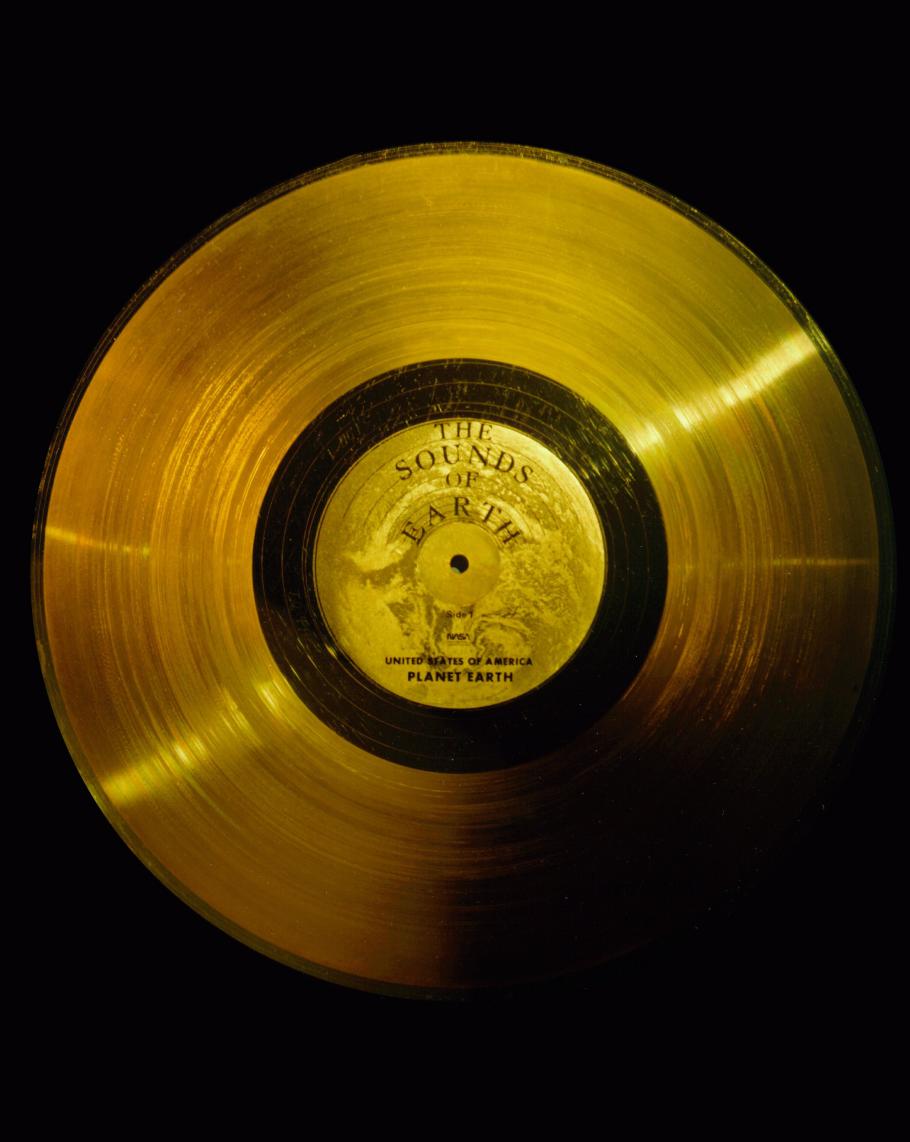
Keep track of the Voyager spacecraft on the official Voyager Interstellar Mission website or follow @NASAVoyager2 on Twitter. † The sun ejects a continuous stream of charged particles (electrons, protons, etc) that is collectively termed the solar wind. The particles are traveling extremely fast and are dense enough to form a very tenuous atmosphere; the heliosphere represents the volume of space where the effects of the solar wind dominate over those of particles in interstellar space. The solar wind particles are moving very much faster than the local speed of sound represented by their low volume density. When the particles begin to interact with interstellar particles and fields (the interaction can be either physically running into other particles or experiencing an electromagnetic force resulting from a charged particle moving within a magnetic field), then they start to slow down. The point at which they become subsonic (rather than their normal hypersonic speed) is the Termination Shock.
We rely on the generous support of donors, sponsors, members, and other benefactors to share the history and impact of aviation and spaceflight, educate the public, and inspire future generations. With your help, we can continue to preserve and safeguard the world’s most comprehensive collection of artifacts representing the great achievements of flight and space exploration.
- Get Involved
- Host an Event

Thank you. You have successfully signed up for our newsletter.
Error message, sorry, there was a problem. please ensure your details are valid and try again..
- Free Timed-Entry Passes Required
- Terms of Use
- Skip to main content
- Keyboard shortcuts for audio player
After a 12.3 billion-mile 'shout,' NASA regains full contact with Voyager 2
Emily Olson
Ayana Archie

A NASA image of one of the twin Voyager space probes. The Jet Propulsion Laboratory lost contact with Voyager 2 on July 21 after mistakenly pointing its antenna 2 degrees away from Earth. On Friday, contact was fully restored. NASA/Getty Images hide caption
A NASA image of one of the twin Voyager space probes. The Jet Propulsion Laboratory lost contact with Voyager 2 on July 21 after mistakenly pointing its antenna 2 degrees away from Earth. On Friday, contact was fully restored.
Talk about a long-distance call.
NASA said it resumed full communications with the Voyager 2 on Friday after almost two weeks of silence from the interstellar spacecraft.
The agency's Jet Propulsion Laboratory said a series of ground antennas, part of the Deep Space Network, registered a carrier signal from Voyager 2 on Tuesday. However, the signal was too faint.
A Deep Space Network facility in Australia then sent "the equivalent of an interstellar 'shout' " to the Voyager 2 telling it to turn its antenna back toward Earth. The signal was sent more than 12.3 billion miles away and it took 37 hours to get a response from the spacecraft, NASA said.
Scientists received a response at about 12:30 a.m. ET Friday. Voyager 2 is now operating normally, returning science and telemetry data, and "remains on its expected trajectory," NASA said.
NASA said Friday that it lost contact with Voyager 2 on July 21 after "a series of planned commands" inadvertently caused the craft to turn its antenna 2 degrees away from the direction of its home planet.

NASA is keeping Voyager 2 going until at least 2026 by tapping into backup power
What might seem like a slight error had big consequences: NASA previously said it wouldn't be able to communicate with the craft until October, when the satellite would go through one of its routine repositioning steps.
"That is a long time to wait, so we'll try sending up commands several times" before October, program manager Suzanne Dodd told The Associated Press.

These are the 4 astronauts who'll take a trip around the moon next year
Even if Voyager 2 had failed to reestablish communications until fall, the engineers expected it to stay moving on its planned trajectory on the edge of the solar system.
Voyager 2 entered interstellar space in November 2018 — more than 40 years since it launched from Cape Canaveral, Fla. To this day, Voyager 2 remains one of only two human-made objects to ever operate outside the heliosphere, which NASA defines as "the protective bubble of particles and magnetic fields generated by the Sun."
Its primary mission was to study the outer solar system, and already, Voyager 2 has proved its status as a planetary pioneer . Equipped with several imaging instruments, the spacecraft is credited with documenting the discovery of 16 new moons, six new rings and Neptune's "Great Dark Spot."

Voyager 2 Bids Adieu To The Heliosphere, Entering Interstellar Space
Voyager 2 is also carrying some precious cargo, like a message in a bottle, should it find itself as the subject of another world's discovery: a golden record containing a variety of natural sounds, greetings in 55 languages and a 90-minute selection of music.
Last month's command mix-up foreshadows the craft's inevitable end an estimated three years from now.
"Eventually, there will not be enough electricity to power even one instrument," reads a NASA page documenting the spacecraft's travels . "Then, Voyager 2 will silently continue its eternal journey among the stars."
Meanwhile, Voyager 2's sister spacecraft, Voyager 1, is still broadcasting and transmitting data just fine from a slightly farther vantage point of 15 billion miles away.
Correction Aug. 3, 2023
A previous version of this article implied that Voyager 2 flew past Uranus in 2018 when, in fact, the spacecraft concluded its encounter with the planet and started heading toward Neptune in 1986. Voyager 2 entered interstellar space in November 2018.
- Jet Propulsion Laboratory
Voyagers Continues to Returns Data from The Edges of the Milky Way

More than two years after Voyager 2 looked Neptune's Great Dark Spot in the eye and darted past the frozen surface of its moon Triton, both Voyager spacecraft are continuing to return data about interplanetary space and some of our stellar neighbors near the edges of the Milky Way.
After the Voyager spacecraft flew by the four giant outer planets -- Jupiter, Saturn, Uranus and Neptune -- their mission might have been over. But, in fact, these 14-year-old twins are just beginning a new phase of their journey, called the Voyager Interstellar Mission (VIM).
As the Voyagers cruise gracefully in the solar wind, their fields, particles and waves instruments are studying the space around them while searching for the elusive heliopause -- the outer edge of our solar system.
The heliopause is the outermost boundary of the solar wind, where the interstellar medium restricts the outward flow of the solar wind and confines it within a magnetic bubble called the heliosphere. The solar wind is made up of electrically charged atomic particles, composed primarily of ionized hydrogen, that stream outward from the Sun. "The termination shock is the first signal that we are approaching the heliopause. It's the area where the solar wind starts slowing down," said Voyager Project Scientist and JPL's Director, Dr. Edward C. Stone. Mission scientists now anticipate that the spacecraft may cross the termination shock by the end of the century. Exactly where the heliopause is remains a mystery. Its long been thought to be located some 75 to 150 astronomical units (AU) from the Sun. (One AU is equal to 150 million kilometers (93 million miles), or the distance from the Earth to the Sun.) Any speculation about where the heliopause is or what it is like, has come only from computer models and theories. "Voyager 1 is likely to return the first direct evidence from the heliopause and what lies beyond it," Stone said.
Yet the Voyagers are not sitting idly by as they wait to cross over into interstellar space. Both spacecraft are involved in an extensive program of ultraviolet astronomy that allows them to study active galaxies, quasars and white dwarf stars, in ways unlike any other spacecraft or telescope in existence.
Voyager's ultraviolet spectrometers are the only way scientists can currently observe celestial objects in a unique region in the short end of the ultraviolet portion of the electromagnetic spectrum. "Voyager's instruments allow it to observe things at wavelengths that are for the most part unavailable to other spacecraft," said Dr. Jay Holberg, a member of Voyager's ultraviolet subsystem team.
The Voyagers have become space-based ultraviolet observatories and their unique location in the universe gives astronomers the best vantage point they have ever had for looking at celestial objects that emit ultraviolet radiation. "The light that Voyager is sensitive to has to be observed in outer space," said Holberg.
Voyager's ultraviolet instruments are best suited to study the two extreme phases of a star's life -- its birth and its death. Thus the Voyagers are currently gathering data on early blue stars as well as other white dwarf stars nearing the end of their lifetime. "Voyager is helping us get a better handle on exactly how much energy these hot stars emit," Holberg said.
Now that Voyager's primary mission of exploring the outer planets is over, there are fewer constraints on the science team when it comes to programming the spacecrafts' observations. "We can sit on these things for very long periods of time and watch these stars go through their phases," Holberg said.
Stars can be very active, but also unpredictable. "We don't know when a star will do something. If we want to sit there and wait, we can do it in the hopes that the star will go through an outburst and Voyager will be there to observe it," he continued. Voyager can now stare at an object for days and even weeks at a time to thoroughly map it and the region around it.
Since the beginning of the interstellar mission, the Voyager project has been conducting a guest observer program which allows astronomers from around the world to make proposals and apply for time to use the Voyager ultraviolet spectrometer in much the same way that astronomers apply for time at ground-based observatories. This program enables scientists to make simultaneous observations of the same object using Voyager and ground-based telescopes.
The cameras on the spacecraft have been turned off and the ultraviolet instrument is the only experiment on the scan platform that is still functioning. Voyager scientists expect to continue to receive data from the ultraviolet spectrometers at least until the year 2000. At that time, there will not be enough electrical power for the heaters to keep the ultraviolet instrument warm enough to operate.
Yet there are several other fields and particle instruments that can continue to send back data as long as the spacecraft stay alive. They include: the cosmic ray subsystem, the low-energy charged particle instrument, the magnetometer, the plasma subsystem, the plasma wave subsystem and the planetary radio astronomy instrument. Barring any catastrophic events, JPL should be able to retrieve this information for at least the next 20 and perhaps even the next 30 years.
"In exploring the four outer planets, Voyager has already had an epic journey of discovery. Even so, their journey is less than half over with more discoveries awaiting the first contact with interstellar space," Stone said. "The Voyagers revealed how limited our imaginations really were about our solar system, and I expect that as they continue toward interstellar space, they will again surprise us with unimagined discoveries of this never-before-visited place which awaits us beyond our planetary neighborhood."
Voyager 1 is now 7 billion kilometers (4.3 billion miles) from Earth, traveling at a heliocentric velocity of 63,800 km/hr (39,700 mph). Voyager 2, traveling in the opposite direction from its twin, is 5.3 billion kilometers (3.3 billion miles) from Earth with a heliocentric velocity of 59,200 km/hr (36,800 mph).
The Voyager Interstellar Mission is managed by JPL and sponsored by NASA's Office of Space Science and Applications, Washington, DC.

First to visit all four giant planets

Voyager 2 is the only spacecraft to visit Uranus and Neptune. The probe is now in interstellar space, the region outside the heliopause, or the bubble of energetic particles and magnetic fields from the Sun.
Mission Type
What is Voyager 2?
NASA's Voyager 2 is the second spacecraft to enter interstellar space. On Dec. 10, 2018, the spacecraft joined its twin – Voyager 1 – as the only human-made objects to enter the space between the stars.
- Voyager 2 is the only spacecraft to study all four of the solar system's giant planets at close range.
- Voyager 2 discovered a 14th moon at Jupiter.
- Voyager 2 was the first human-made object to fly past Uranus.
- At Uranus, Voyager 2 discovered 10 new moons and two new rings.
- Voyager 2 was the first human-made object to fly by Neptune.
- At Neptune, Voyager 2 discovered five moons, four rings, and a "Great Dark Spot."
In Depth: Voyager 2
The two-spacecraft Voyager missions were designed to replace original plans for a “Grand Tour” of the planets that would have used four highly complex spacecraft to explore the five outer planets during the late 1970s.
NASA canceled the plan in January 1972 largely due to anticipated costs (projected at $1 billion) and instead proposed to launch only two spacecraft in 1977 to Jupiter and Saturn. The two spacecraft were designed to explore the two gas giants in more detail than the two Pioneers (Pioneers 10 and 11) that preceded them.
In 1974, mission planners proposed a mission in which, if the first Voyager was successful, the second one could be redirected to Uranus and then Neptune using gravity assist maneuvers.
Each of the two spacecraft was equipped with a slow-scan color TV camera to take images of the planets and their moons and each also carried an extensive suite of instruments to record magnetic, atmospheric, lunar, and other data about the planetary systems.
The design of the two spacecraft was based on the older Mariners, and they were known as Mariner 11 and Mariner 12 until March 7, 1977, when NASA Administrator James C. Fletcher (1919-1991) announced that they would be renamed Voyager.
Power was provided by three plutonium oxide radioisotope thermoelectric generators (RTGs) mounted at the end of a boom.
Voyager 2 at Jupiter
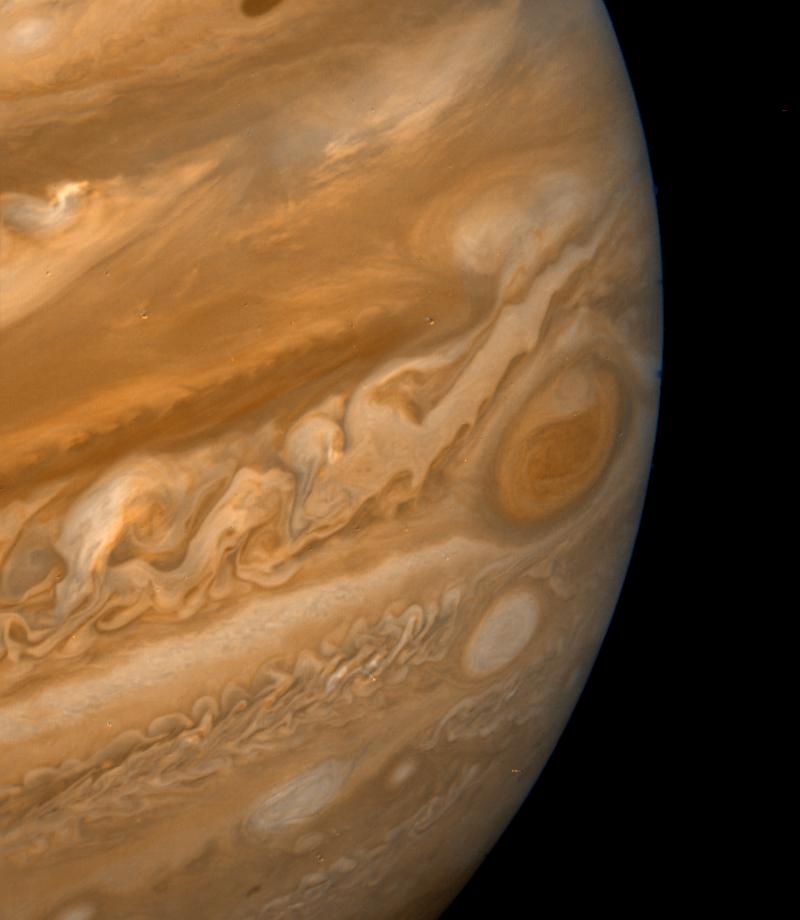
Voyager 2 began transmitting images of Jupiter April 24, 1979, for time-lapse movies of atmospheric circulation. Unlike Voyager 1, Voyager 2 made close passes to the Jovian moons on its way into the system, with scientists especially interested in more information from Europa and Io (which necessitated a 10 hour-long “volcano watch”).
During its encounter, it relayed back spectacular photos of the entire Jovian system, including its moons Callisto, Ganymede, Europa (at a range of about 127,830 miles or 205,720 kilometers, much closer than Voyager 1), Io, and Amalthea, all of which had already been surveyed by Voyager 1.
Voyager 2’s closest encounter to Jupiter was at 22:29 UT July 9, 1979, at a range of about 400,785 miles (645,000 kilometers). It transmitted new data on the planet’s clouds, its newly discovered four moons, and ring system as well as 17,000 new pictures.
When the earlier Pioneers flew by Jupiter, they detected few atmospheric changes from one encounter to the second, but Voyager 2 detected many significant changes, including a drift in the Great Red Spot as well as changes in its shape and color.
With the combined cameras of the two Voyagers, at least 80% of the surfaces of Ganymede and Callisto were mapped out to a resolution of about 3 miles (5 kilometers).
Voyager 2 at Saturn
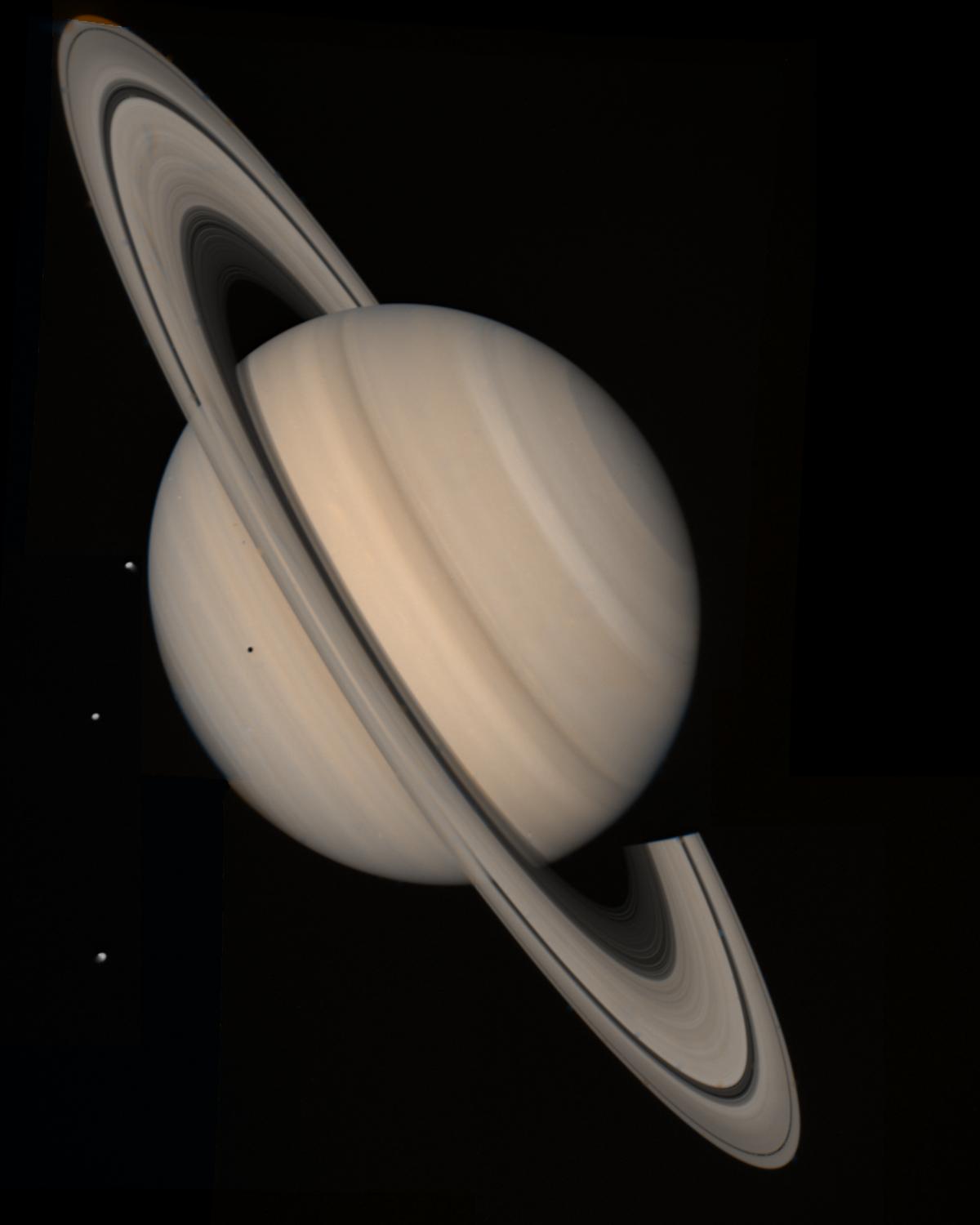
Following a course correction two hours after its closest approach to Jupiter, Voyager 2 sped to Saturn, its trajectory determined to a large degree by a decision made in January 1981, to try to send the spacecraft to Uranus and Neptune later in the decade.
Its encounter with the sixth planet began Aug. 22, 1981, two years after leaving the Jovian system, with imaging of the moon Iapetus. Once again, Voyager 2 repeated the photographic mission of its predecessor, although it actually flew about 14,290 miles (23,000 kilometers) closer to Saturn. The closest encounter to Saturn was at 01:21 UT Aug. 26, 1981, at a range of about 63,000 miles (101,000 kilometers).
The spacecraft provided more detailed images of the ring “spokes” and kinks, and also the F-ring and its shepherding moons, all found by Voyager 1. Voyager 2’s data suggested that Saturn’s A-ring was perhaps only about 980 feet (300 meters) thick.
As it flew behind and up past Saturn, the probe passed through the plane of Saturn’s rings at a speed of 8 miles per second (13 kilometers per second). For several minutes during this phase, the spacecraft was hit by thousands of micron-sized dust grains that created “puff” plasma as they were vaporized. Because the vehicle’s attitude was repeatedly shifted by the particles, attitude control jets automatically fired many times to stabilize the vehicle.
During the encounter, Voyager 2 also photographed the Saturn moons Hyperion (the “hamburger moon”), Enceladus, Tethys, and Phoebe as well as the more recently discovered Helene, Telesto and Calypso.
Voyager 2 at Uranus
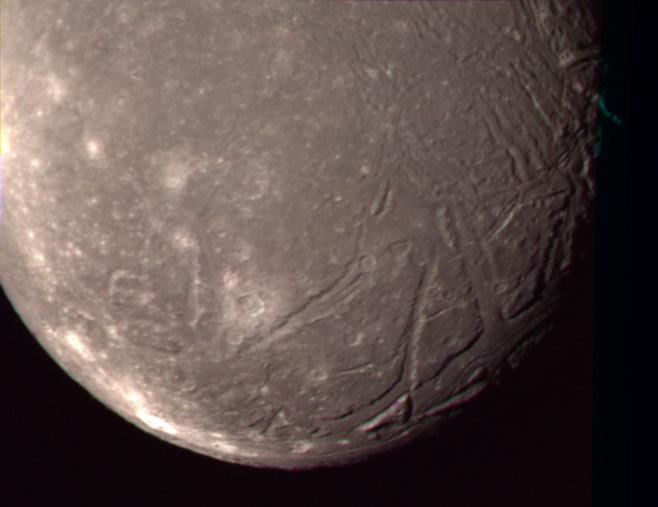
Although Voyager 2 had fulfilled its primary mission goals with the two planetary encounters, mission planners directed the veteran spacecraft to Uranus—a journey that would take about 4.5 years.
In fact, its encounter with Jupiter was optimized in part to ensure that future planetary flybys would be possible.
The Uranus encounter’s geometry was also defined by the possibility of a future encounter with Neptune: Voyager 2 had only 5.5 hours of close study during its flyby.
Voyager 2 was the first human-made object to fly past the planet Uranus.
Long-range observations of the planet began Nov. 4, 1985, when signals took approximately 2.5 hours to reach Earth. Light conditions were 400 times less than terrestrial conditions. Closest approach to Uranus took place at 17:59 UT Jan. 24, 1986, at a range of about 50,640 miles (81,500 kilometers).
During its flyby, Voyager 2 discovered 10 new moons (given such names as Puck, Portia, Juliet, Cressida, Rosalind, Belinda, Desdemona, Cordelia, Ophelia, and Bianca -- obvious allusions to Shakespeare), two new rings in addition to the “older” nine rings, and a magnetic field tilted at 55 degrees off-axis and off-center.
The spacecraft found wind speeds in Uranus’ atmosphere as high as 450 miles per hour (724 kilometers per hour) and found evidence of a boiling ocean of water some 497 miles (800 kilometers) below the top cloud surface. Its rings were found to be extremely variable in thickness and opacity.
Voyager 2 also returned spectacular photos of Miranda, Oberon, Ariel, Umbriel, and Titania, five of Uranus’ larger moons. In flying by Miranda at a range of only 17,560 miles (28,260 kilometers), the spacecraft came closest to any object so far in its nearly decade-long travels. Images of the moon showed a strange object whose surface was a mishmash of peculiar features that seemed to have no rhyme or reason. Uranus itself appeared generally featureless.
The spectacular news of the Uranus encounter was interrupted the same week by the tragic Challenger accident that killed seven astronauts during their space shuttle launch Jan. 28, 1986.
Voyager 2 at Neptune
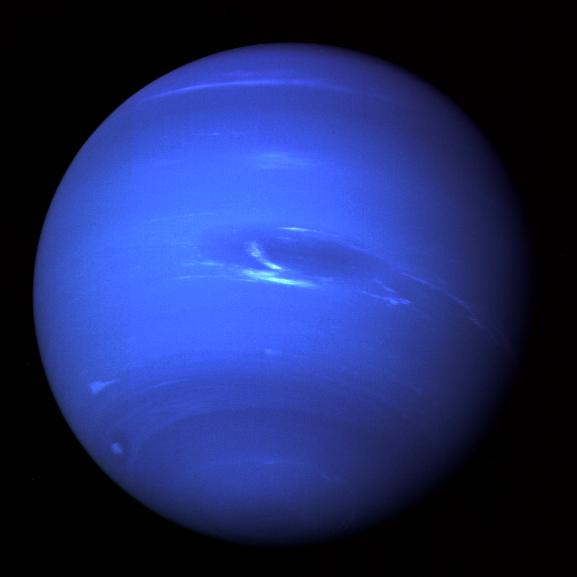
Following the Uranus encounter, the spacecraft performed a single midcourse correction Feb. 14, 1986—the largest ever made by Voyager 2—to set it on a precise course to Neptune.
Voyager 2’s encounter with Neptune capped a 4.3 billion-mile (7 billion-kilometer) journey when, on Aug. 25, 1989, at 03:56 UT, it flew about 2,980 miles (4,800 kilometers) over the cloud tops of the giant planet, the closest of its four flybys. It was the first human-made object to fly by the planet. Its 10 instruments were still in working order at the time.
During the encounter, the spacecraft discovered six new moons (Proteus, Larissa, Despina, Galatea, Thalassa, and Naiad) and four new rings.
The planet itself was found to be more active than previously believed, with 680-mile (1,100-kilometer) per hour winds. Hydrogen was found to be the most common atmospheric element, although the abundant methane gave the planet its blue appearance.
Images revealed details of the three major features in the planetary clouds—the Lesser Dark Spot, the Great Dark Spot, and Scooter.
Voyager photographed two-thirds of Neptune’s largest moon Triton, revealing the coldest known planetary body in the solar system and a nitrogen ice “volcano” on its surface. Spectacular images of its southern hemisphere showed a strange, pitted cantaloupe-type terrain.
The flyby of Neptune concluded Voyager 2’s planetary encounters, which spanned an amazing 12 years in deep space, virtually accomplishing the originally planned “Grand Tour” of the solar system, at least in terms of targets reached if not in science accomplished.
Voyager 2's Interstellar Mission
Once past the Neptune system, Voyager 2 followed a course below the ecliptic plane and out of the solar system. Approximately 35 million miles (56 million kilometers) past the encounter, Voyager 2’s instruments were put in low power mode to conserve energy.
After the Neptune encounter, NASA formally renamed the entire project the Voyager Interstellar Mission (VIM).
Of the four spacecraft sent out to beyond the environs of the solar system in the 1970s, three of them -- Voyagers 1 and 2 and Pioneer 11 -- were all heading in the direction of the solar apex, i.e., the apparent direction of the Sun’s travel in the Milky Way galaxy, and thus would be expected to reach the heliopause earlier than Pioneer 10 which was headed in the direction of the heliospheric tail.
In November 1998, 21 years after launch, nonessential instruments were permanently turned off, leaving seven instruments still operating.
At 9.6 miles per second (15.4 kilometers per second) relative to the Sun, it will take about 19,390 years for Voyager 2 to traverse a single light year.

Asif Siddiqi
Beyond Earth: A Chronicle of Deep Space Exploration
Through the turn of the century, NASA's Jet Propulsion Laboratory (JPL) continued to receive ultraviolet and particle fields data. For example, on Jan. 12, 2001, an immense shock wave that had blasted out of the outer heliosphere on July 14, 2000, finally reached Voyager 2. During its six-month journey, the shock wave had plowed through the solar wind, sweeping up and accelerating charged particles. The spacecraft provided important information on high-energy shock-energized ions.
On Aug. 30, 2007, Voyager 2 passed the termination shock and then entered the heliosheath. By Nov. 5, 2017, the spacecraft was 116.167 AU (about 10.8 billion miles or about 17.378 billion kilometers) from Earth, moving at a velocity of 9.6 miles per second (15.4 kilometers per second) relative to the Sun, heading in the direction of the constellation Telescopium. At this velocity, it would take about 19,390 years to traverse a single light-year.
On July 8, 2019, Voyager 2 successfully fired up its trajectory correction maneuver thrusters and will be using them to control the pointing of the spacecraft for the foreseeable future. Voyager 2 last used those thrusters during its encounter with Neptune in 1989.
The spacecraft's aging attitude control thrusters have been experiencing degradation that required them to fire an increasing and untenable number of pulses to keep the spacecraft's antenna pointed at Earth. Voyager 1 had switched to its trajectory correction maneuver thrusters for the same reason in January 2018.
To ensure that both vintage robots continue to return the best scientific data possible from the frontiers of space, mission engineers are implementing a new plan to manage them. The plan involves making difficult choices, particularly about instruments and thrusters.

National Space Science Data Center: Voyager 2
A library of technical details and historic perspective.

A comprehensive history of missions sent to explore beyond Earth.
Discover More Topics From NASA


Voyager 1 enters interstellar space in an illustration. The NASA spacecraft officially crossed into the space between the stars in 2012.
Both of NASA's Voyager spacecraft are now interstellar. Where to next?
Launched in 1977, the twin probes will likely outlive the sun. Find out what star systems they’ll meet as they head deeper into the galaxy.
NASA’s twin Voyager spacecraft have been traveling the interstellar road for more than 40 years, sweeping past the giant planets of the outer solar system before heading to the very fringes of our sun’s domain. Now, one probe has achieved a milestone in exploration: On December 10, NASA announced that Voyager 2 has entered interstellar space , six years after Voyager 1 first crossed the threshold. The twins are the only two spacecraft ever to venture so far from home.
To confirm Voyager 2's exit, scientists analyzed data from the spacecraft's Plasma Science Experiment , which measured the heliopause—the boundary between the sun's protective plasma bubble and interstellar space. On November 5, the instrument recorded a steep decline in particles from the sun's plasma. At the same time, Voyager 2 saw more high-energy particles from elsewhere in the galaxy, confirming that the probe had left our cosmic cul-de-sac.
"Working on Voyager makes me feel like an explorer, because everything we're seeing is new," MIT researcher John Richardson, the principal investigator for the plasma experiment, said in a statement . "Even though Voyager 1 crossed the heliopause in 2012, it did so at a different place and a different time, and without the PLS data. So we're still seeing things that no one has seen before."
But even at more than 11 billion miles from the sun, the Voyagers’ story is just beginning. On their current paths, both probes will still be heading outward across the galaxy eons after they escape the gravitational tug of the sun, and perhaps long after our star dies in four or five billion years. Should the spacecraft ever be intercepted by an alien civilization, two golden records bearing the sights and sounds of planet Earth could play the last whispers of a long-dead planet.
Assuming they stay on course, it’s going to be a lonely trip for the Voyagers, because even though our Earthly skies appear to glitter with countless pinpricks of light, space is mostly empty. Distances between the stars are so vast that even when our galaxy smashes into the one next door , not much will happen in the way of stellar collisions.
Still, according to astronomers’ predictions, their cosmic treks will bring the Voyagers close to several starry milestones and a dust cloud or three over the next hundred thousand or so years. Here are some of the known cosmic landmarks the Voyagers could meet in their relatively near futures.
For Hungry Minds
Launched from Cape Canaveral, Florida, on August 20, 1977, the dairy cow-size Voyager 2 began its odyssey with a grand tour of the outer solar system, making vital discoveries at Jupiter and Saturn and returning some of the best views yet of Uranus and Neptune.
The probe is now dipping below the plane of the solar system at roughly 34,500 miles an hour and heading celestially south, toward the constellation Sagittarius. On November 5, 2018, it crossed the heliopause, exiting the sun’s protective plasma bubble.
Voyager 2 may be freshly interstellar, but it won’t be anywhere near another star until 40,000 years from now, when it will pass within 1.7 light-years of the small red dwarf star Ross 248. At that point, Ross 248 will be the closest star to our sun, briefly eclipsing the Alpha Centauri system’s claim to fame as its path through the galaxy brings it just 3.02 light-years away.
About 61,000 years from now, Voyager 2 will pass beyond the Oort Cloud—a large, diffuse swarm of icy objects that is thought to extend as far as 200,000 times farther from the sun than Earth, says Wesleyan University’s Seth Redfield .
Voyager 2 may be freshly interstellar, but it won’t be anywhere near another star until 40,000 years from now.
Most scientists think the Oort cloud is the source of comets that take thousands of years to complete one orbit around the sun. It could also be the true boundary of the solar system, if you consider that to be the point where the sun’s gravitational influence drops off.
“The outer edge of the Oort Cloud is approximately where that is,” says Redfield, who has used the Hubble Space Telescope to study the Voyagers’ paths in detail for the next hundred thousand years, and more crudely for the next several million.
Next, in the year 298,000 Voyager 2 will swing within about four light-years of Sirius, the brightest star in Earth’s sky. It’ll then brush by two stars, delta Pav and GJ 754, about a hundred thousand years later.
Voyager 1 followed its twin into the sky on September 5, 1977. It rendezvoused with Jupiter and Saturn in 1979 and 1980, returning some spectacular views of volcanoes erupting on the Jovian moon Io, then continued outward.
You May Also Like

Why go back to the moon? NASA’s Artemis program has even bigger ambitions

'The sky is opening up': NASA's Webb Telescope captures jaw-dropping views of the cosmos

Why NASA's high-stakes maneuver to redirect an asteroid surprised its own scientists
On February 14, 1990, it swiveled to capture the solar system retreating from its view, including a series of images that revealed our pale blue planet looking like “a mote of dust suspended in a sunbeam,” according to Carl Sagan.
Now traveling more than 35,000 miles an hour in the direction of the constellation Ophiuchus, Voyager 1 is the fastest human-made object in space. In 2013, it became the first spacecraft to leave the heliosphere and cross into interstellar space.
In the year 40,272, the spacecraft will sail within 1.7 light-years of the star Gliese 445 in the constellation Camelopardalis.
In 56,000 years, Voyager 1 will exit the Oort cloud, then brush by the stars GJ 686 and GJ 678 in 570,000 years.
Wandering Wonders
Beyond that, both spacecraft will continue on their journeys outward, passing through scattered dust clouds on their way through the local bubble, a cavern of relatively empty space blown by tempestuous dying stars. They’ll exit this bubble in 5.7 and 6.3 million years, respectively.
From there, things get murky. The peculiar motions of stars and dust clouds orbiting the galactic center aren’t well known yet, and the spacecraft could be slowed by sailing through dust clouds. Plus, gravitational encounters with things like wandering, starless planets could bounce the probes around like billiard balls.
“There may be a whole population of rogue planets out in interstellar space,” Redfield says. “A mildly close encounter with one of those could change the itinerary of the Voyagers.”
Ultimately, like the stars in the Milky Way, the Voyagers will march to the galaxy’s tune and orbit its core for the rest of their lives.
“All the stars in the solar neighborhood are in an orbit around the center of the Milky Way, with orbital periods of 225 to 250 million years,” says Voyager project scientist Ed Stone . “The Voyagers will also be in such independent orbits, completing an orbit every 225 million years for billions of years until a collision with another galaxy disrupts this orderly flow.”
That might occur in four billion years, when the neighboring Andromeda galaxy smashes into the Milky Way and rearranges our skies in spectacular ways.
How the Voyagers’ ultimate demise occurs—whether it’s death by a thousand micrometeorite impacts, or one large improbable collision—remains a mystery. It’s even possible the Voyagers will outlive the solar system, surviving long after the sun’s death sculpts our neighborhood into a dramatically different place.
“The universe tends to do a great job of preserving its occupants,” Redfield says. After all, “the objects in our solar system, even small objects, have been around for 4.5 billion years.”
Related Topics

Why NASA’s Interstellar Mission Almost Didn’t Happen

U.S. returns to the moon as NASA's Odysseus successfully touches down

What is causing these massive, mysterious explosions in space?

The world’s most powerful telescope is rewriting the story of space and time
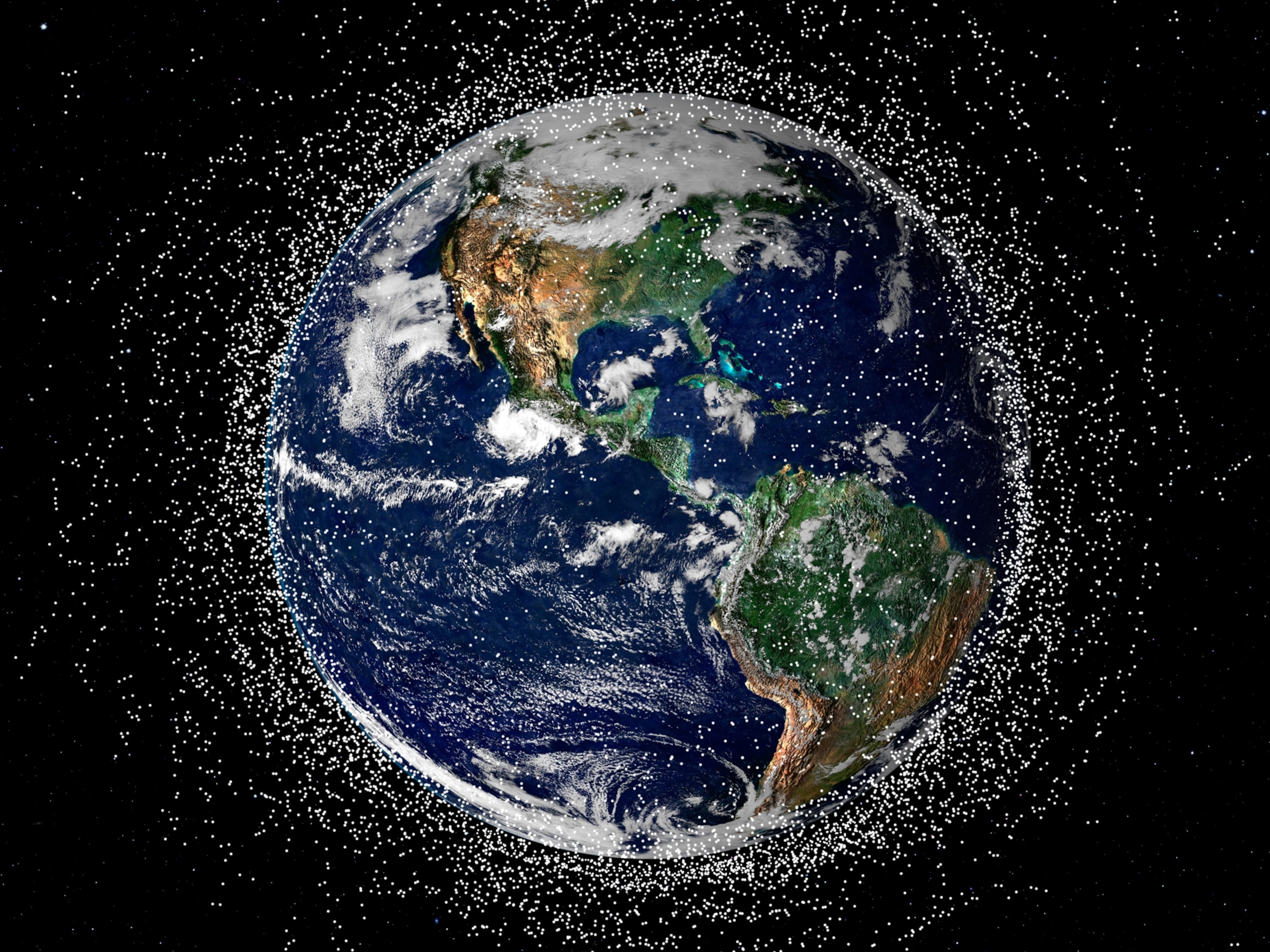
NASA has a plan to clean up space junk—but is going green enough?
- Environment
- Paid Content
- Photography
- Perpetual Planet
History & Culture
- History & Culture
- History Magazine
- Mind, Body, Wonder
- Terms of Use
- Privacy Policy
- Your US State Privacy Rights
- Children's Online Privacy Policy
- Interest-Based Ads
- About Nielsen Measurement
- Do Not Sell or Share My Personal Information
- Nat Geo Home
- Attend a Live Event
- Book a Trip
- Inspire Your Kids
- Shop Nat Geo
- Visit the D.C. Museum
- Learn About Our Impact
- Support Our Mission
- Advertise With Us
- Customer Service
- Renew Subscription
- Manage Your Subscription
- Work at Nat Geo
- Sign Up for Our Newsletters
- Contribute to Protect the Planet
Copyright © 1996-2015 National Geographic Society Copyright © 2015-2024 National Geographic Partners, LLC. All rights reserved
Things are finally looking up for the Voyager 1 interstellar spacecraft
Two of the four science instruments aboard the Voyager 1 spacecraft are now returning usable data after months of transmitting only gibberish, NASA scientists have announced.
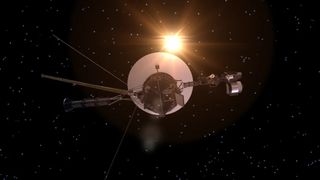
I was once sitting with my father while Googling how far away various things in the solar system are from Earth. He was looking for exact numbers, and very obviously grew more invested with each new figure I shouted out. I was thrilled. The moon? On average, 238,855 miles (384,400 kilometers) away. The James Webb Space Telescope ? Bump that up to about a million miles (1,609,344 km) away. The sun? 93 million miles (149,668,992 km) away. Neptune ? 2.8 billion miles (4.5 billion km) away. "Well, wait until you hear about Voyager 1," I eventually said, assuming he was aware of what was coming. He was not.
"NASA's Voyager 1 interstellar spacecraft actually isn't even in the solar system anymore," I announced. "Nope, it's more than 15 billion miles (24 billion km) away from us — and it's getting even farther as we speak." I can't quite remember his response, but I do indeed recall an expression of sheer disbelief. There were immediate inquiries about how that's even physically possible. There were bewildered laughs, different ways of saying "wow," and mostly, there was a contagious sense of awe. And just like that, a new Voyager 1 fan was born.
It is easy to see why Voyager 1 is among the most beloved robotic space explorers we have — and it is thus easy to understand why so many people felt a pang to their hearts several months ago, when Voyager 1 stopped talking to us.
Related: After months of sending gibberish to NASA, Voyager 1 is finally making sense again
For reasons unknown at the time, this spacecraft began sending back gibberish in place of the neatly organized and data-rich 0's and 1's it had been providing since its launch in 1977 . It was this classic computer language which allowed Voyager 1 to converse with its creators while earning the title of "farthest human made object." It's how the spacecraft relayed vital insight that led to the discovery of new Jovian moons and, thanks to this sort of binary podcast, scientists incredibly identified a new ring of Saturn and created the solar system's first and only "family portrait." This code, in essence, is crucial to Voyager 1's very being.
Plus, to make matters worse, the issue behind the glitch turned out to be associated with the craft's Flight Data System, which is literally the system that transmits information about Voyager 1's health so scientists can correct any issues that arise. Issues like this one. Furthermore, because of the spacecraft's immense distance from its operators on Earth, it takes about 22.5 hours for a transmission to reach the spacecraft, and then 22.5 hours to receive a transmission back. Alas, things weren't looking good for a while — for about five months, to be precise.
But then, on April 20, Voyager 1 finally phoned home with legible 0's and legible 1's.
Sign up for the Live Science daily newsletter now
Get the world’s most fascinating discoveries delivered straight to your inbox.
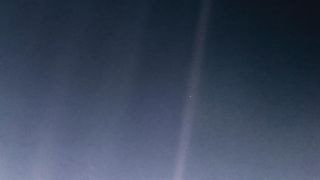
"The team had gathered early on a weekend morning to see whether telemetry would return," Bob Rasmussen, a member of the Voyager flight team, told Space.com. "It was nice to have everyone assembled in one place like this to share in the moment of learning that our efforts had been successful. Our cheer was both for the intrepid spacecraft and for the comradery that enabled its recovery."
And then, on May 22 , Voyager scientists released the welcome announcement that the spacecraft has successfully resumed returning science data from two of its four instruments, the plasma wave subsystem and magnetometer instrument. They're now working on getting the other two, the cosmic ray subsystem and low energy charged particle instrument, back online as well. Though there technically are six other instruments onboard Voyager, those had been out of commission for some time.
The comeback
Rasmussen was actually a member of the Voyager team in the 1970s, having worked on the project as a computer engineer before leaving for other missions including Cassini , which launched the spacecraft that taught us almost everything we currently know about Saturn. In 2022, however, he returned to Voyager because of a separate dilemma with the mission — and has remained on the team ever since.
"There are many of the original people who were there when Voyager launched, or even before, who were part of both the flight team and the science team," Linda Spilker, a planetary scientist at NASA's Jet Propulsion Laboratory , who also worked on the Voyager mission, told Space.com in the This Week from Space podcast on the TWiT network. "It's a real tribute to Voyager — the longevity not only of the spacecraft, but of the people on the team."
To get Voyager 1 back online, in rather cinematic fashion, the team devised a complex workaround that prompted the FDS to send a copy of its memory back to Earth. Within that memory readout, operators managed to discover the crux of the problem — a corrupted code spanning a single chip — which was then remedied through another (honestly, super interesting ) process to modify the code. On the day Voyager 1 finally spoke again, "you could have heard a pin drop in the room," Spilker said. "It was very silent. Everybody's looking at the screen, waiting and watching."
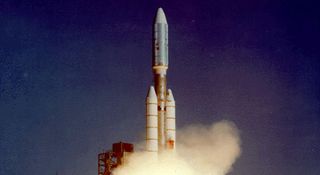
Of course, Spilker also brought in some peanuts for the team to munch on — but not just any peanuts. Lucky peanuts.
It's a longstanding tradition at JPL to have a peanut feast before major mission events like launches, milestones and, well, the possible resurrection of Voyager 1. It began in the 1960s, when the agency was trying to launch the Ranger 7 mission that was meant to take pictures of and collect data about the moon's surface. Rangers 1 through 6 had all failed, so Ranger 7 was a big deal. As such, the mission's trajectory engineer, Dick Wallace, brought lots of peanuts for the team to nibble on and relax. Sure enough, Ranger 7 was a success and, as Wallace once said, "the rest is history."
Voyager 1 needed some of those positive snacky vibes.
"It'd been five months since we'd had any information," Spilker explained. So, in this room of silence besides peanut-eating-noises, Voyager 1 operators sat at their respective system screens, waiting.
"All of a sudden it started to populate — the data," Spilker said. That's when the programmers who had been staring at those screens in anticipation leapt out of their seats and began to cheer: "They were the happiest people in the room, I think, and there was just a sense of joy that we had Voyager 1 back."
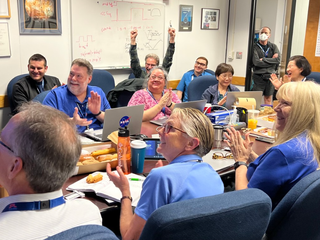
Eventually, Rasmussen says the team was able to conclude that the failure probably occurred due to a combination of aging and radiation damage by which energetic particles in space bombarded the craft. This is also why he believes it wouldn't be terribly surprising to see a similar failure occur in the future, seeing as Voyager 1 is still roaming beyond the distant boundaries of our stellar neighborhood just like its spacecraft twin, Voyager 2 .
To be sure, the spacecraft isn't fully fixed yet — but it's lovely to know things are finally looking up, especially with the recent news that some of its science instruments are back on track. And, at the very least, Rasmussen assures that nothing the team has learned so far has been alarming. "We're confident that we understand the problem well," he said, "and we remain optimistic about getting everything back to normal — but we also expect this won't be the last."

In fact, as Rasmussen explains, Voyager 1 operators first became optimistic about the situation just after the root cause of the glitch had been determined with certainty. He also emphasizes that the team's spirits were never down. "We knew from indirect evidence that we had a spacecraft that was mostly healthy," he said. "Saying goodbye was not on our minds."
"Rather," he continued, "we wanted to push toward a solution as quickly as possible so other matters on board that had been neglected for months could be addressed. We're now calmly moving toward that goal."
The future of Voyager's voyage
It can't be ignored that, over the last few months, there has been an air of anxiety and fear across the public sphere that Voyager 1 was slowly moving toward sending us its final 0 and final 1. Headlines all over the internet, one written by myself included , have carried clear, negative weight. I think it's because even if Voyager 2 could technically carry the interstellar torch post-Voyager 1, the prospect of losing Voyager 1 felt like the prospect of losing a piece of history.
"We've crossed this boundary called the heliopause," Spilker explained of the Voyagers. "Voyager 1 crossed this boundary in 2012; Voyager 2 crossed it in 2018 — and, since that time, were the first spacecraft ever to make direct measurements of the interstellar medium." That medium basically refers to material that fills the space between stars. In this case, that's the space between other stars and our sun, which, though we don't always think of it as one, is simply another star in the universe. A drop in the cosmic ocean.
"JPL started building the two Voyager spacecraft in 1972," Spilker explained. "For context, that was only three years after we had the first human walk on the moon — and the reason we started that early is that we had this rare alignment of the planets that happens once every 176 years ." It was this alignment that could promise the spacecraft checkpoints across the solar system, including at Jupiter, Saturn, Uranus and Neptune. Those checkpoints were important for the Voyagers in particular. Alongside planetary visits come gravity assists, and gravity assists can help fling stuff within the solar system — and, now we know, beyond.
As the first humanmade object to leave the solar system, as a relic of America's early space program, and as a testament to how robust even decades-old technology can be, Voyager 1 has carved out the kind of legacy usually reserved for remarkable things lost to time.

"Our scientists are eager to see what they’ve been missing," Rasmussen remarked. "Everyone on the team is self-motivated by their commitment to this unique and important project. That's where the real pressure comes from."
Still, in terms of energy, the team's approach has been clinical and determined.
— NASA's Voyager 1 sends readable message to Earth after 4 nail-biting months of gibberish
— NASA engineers discover why Voyager 1 is sending a stream of gibberish from outside our solar system
— NASA's Voyager 1 probe hasn't 'spoken' in 3 months and needs a 'miracle' to save it
"No one was ever especially excited or depressed," he said. "We're confident that we can get back to business as usual soon, but we also know that we're dealing with an aging spacecraft that is bound to have trouble again in the future. That's just a fact of life on this mission, so not worth getting worked up about."
Nonetheless, I imagine it's always a delight for Voyager 1's engineers to remember this robotic explorer occupies curious minds around the globe. (Including my dad's mind now, thanks to me and Google.)
As Rasmussen puts it: "It's wonderful to know how much the world appreciates this mission."
Originally posted on Space.com .
Monisha Ravisetti is Space.com's Astronomy Editor. She covers black holes, star explosions, gravitational waves, exoplanet discoveries and other enigmas hidden across the fabric of space and time. Previously, she was a science writer at CNET, and before that, reported for The Academic Times. Prior to becoming a writer, she was an immunology researcher at Weill Cornell Medical Center in New York. She graduated from New York University in 2018 with a B.A. in philosophy, physics and chemistry. She spends too much time playing online chess. Her favorite planet is Earth.
China's secret space plane has released another unknown object over Earth
NASA details plan to build a levitating robot train on the moon
Earth from space: Shapeshifting rusty river winds through Madagascar's 'red lands'
Most Popular
- 2 Why are so many ancient Egyptians buried at the Saqqara necropolis?
- 3 Elusive 'octopus squid' with world's largest biological lights attacks camera in striking new video
- 4 3,500-year-old rock art of wild sheep and double-humped camels revealed in Kazakhstan
- 5 Solar power generated enough heat to power a steel furnace
- 2 Wreck of WWII 'Hit 'Em Harder' submarine, which sank with 79 crew on board, discovered in South China Sea
- 3 3,500-year-old rock art of wild sheep and double-humped camels revealed in Kazakhstan
- 4 GPT-4 didn't ace the bar exam after all, MIT research suggests — it didn't even break the 70th percentile
- 5 32 unusual medical cases
NASA's interstellar Voyager 1 spacecraft isn't doing so well — here's what we know
Since late 2023, engineers have been trying to get the Voyager spacecraft back online.
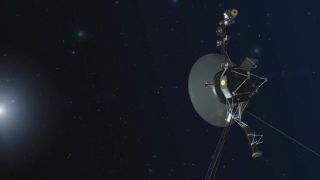
On Dec. 12, 2023, NASA shared some worrisome news about Voyager 1, the first probe to walk away from our solar system 's gravitational party and enter the isolation of interstellar space . Surrounded by darkness, Voyager 1 seems to be glitching.
It has been out there for more than 45 years, having supplied us with a bounty of treasure like the discovery of two new moons of Jupiter, another incredible ring of Saturn and the warm feeling that comes from knowing pieces of our lives will drift across the cosmos even after we're gone. (See: The Golden Record .) But now, Voyager 1 's fate seems to be uncertain.
As of Feb. 6, NASA said the team remains working on bringing the spacecraft back to proper health. "Engineers are still working to resolve a data issue on Voyager 1," NASA's Jet Propulsion Laboratory said in a post on X (formerly Twitter). "We can talk to the spacecraft, and it can hear us, but it's a slow process given the spacecraft's incredible distance from Earth."
Related: NASA's interstellar Voyager probes get software updates beamed from 12 billion miles away
So, on the bright side, even though Voyager 1 sits so utterly far away from us, ground control can actually communicate with it. In fact, last year, scientists beamed some software updates to the spacecraft as well as its counterpart, Voyager 2 , from billions of miles away. Though on the dimmer side, due to that distance, a single back-and-forth communication between Voyager 1 and anyone on Earth takes a total of 45 hours. If NASA finds a solution, it won't be for some time .
The issue, engineers realized, has to do with one of Voyager 1's onboard computers known as the Flight Data System, or FDS. (The backup FDS stopped working in 1981.)
"The FDS is not communicating properly with one of the probe's subsystems, called the telemetry modulation unit (TMU)," NASA said in a blog post. "As a result, no science or engineering data is being sent back to Earth." This is of course despite the fact that ground control can indeed send information to Voyager 1, which, at the time of writing this article , sits about 162 AU's from our planet. One AU is equal to the distance between the Earth and the sun , or 149,597,870.7 kilometers (92,955,807.3 miles).
Get the Space.com Newsletter
Breaking space news, the latest updates on rocket launches, skywatching events and more!
From the beginning
Voyager 1's FDS dilemma was first noticed last year , after the probe's TMU stopped sending back clear data and started procuring a bunch of rubbish.
As NASA explains in the blog post, one of the FDS' core jobs is to collect information about the spacecraft itself, in terms of its health and general status. "It then combines that information into a single data 'package' to be sent back to Earth by the TMU," the post says. "The data is in the form of ones and zeros, or binary code."
However, the TMU seemed to be shuffling back a non-intelligible version of binary code recently. Or, as the team puts it, it seems like the system is "stuck." Yes, the engineers tried turning it off and on again.
That didn't work.
— SpaceX's Starship to launch 'Starlab' private space station in late 2020s
— Wonder what it's like to fall into Uranus? These scientists do, too
— Scientists' predictions for the long-term future of the Voyager Golden Records will blow your mind
Then, in early February, Suzanne Dodd, Voyager project manager at NASA's Jet Propulsion Laboratory, told Ars Technica that the team might have pinpointed what's going on with the FDS at last. The theory is that the problem lies somewhere with the FDS' memory; there might be a computer bit that got corrupted. Unfortunately, though, because the FDS and TMU work together to relay information about the spacecraft's health, engineers are having a hard time figuring out where exactly the possible corruption may exist. The messenger is the one that needs a messenger.
They do know, however, that the spacecraft must be alive because they are receiving what's known as a "carrier tone." Carrier tone wavelengths don't carry information, but they are signals nonetheless, akin to a heartbeat. It's also worth considering that Voyager 1 has experienced problems before, such as in 2022 when the probe's "attitude articulation and control system" exhibited some blips that were ultimately patched up. Something similar happened to Voyager 2 during the summer of 2023, when Voyager 1's twin suffered some antenna complications before coming right back online again.
Still, Dodd says this situation has been the most serious since she began working on the historic Voyager mission.
Join our Space Forums to keep talking space on the latest missions, night sky and more! And if you have a news tip, correction or comment, let us know at: [email protected].
Monisha Ravisetti is Space.com's Astronomy Editor. She covers black holes, star explosions, gravitational waves, exoplanet discoveries and other enigmas hidden across the fabric of space and time. Previously, she was a science writer at CNET, and before that, reported for The Academic Times. Prior to becoming a writer, she was an immunology researcher at Weill Cornell Medical Center in New York. She graduated from New York University in 2018 with a B.A. in philosophy, physics and chemistry. She spends too much time playing online chess. Her favorite planet is Earth.
NASA's Voyager 1 glitch has scientists sad yet hopeful: 'Voyager 2 is still going strong'
NASA's Voyager 1 probe in interstellar space can't phone home (again) due to glitch
Astrophotographer captures stunning close-up views of sunspot region that spawned May's auroras
- Classical Motion There must be more to this story. Let me see if I have this right. They can receive a carrier. But the modulator gives them junk. Or possibly the processor's memory. And they can send new software. New instructions. So, why not simply use the packet data, to key the carrier on and off. OOK On and Off Keying. Telegraphy. Reply
Admin said: NASA's Voyager 1 deep space probe started glitching last year, and scientists aren't sure they can fix it. NASA's interstellar Voyager 1 spacecraft isn't doing so well — here's what we know : Read more
- Classical Motion I wish something would kick one of them back to us. I would love to see an analysis of every cubic cm of it. Reply
- billslugg Modulating the carrier wave would do no good unless the carrier knew what information to send us. The unit that failed takes the raw data and then tells the carrier what to say. Without the modulation unit there is no data to send. Reply
Classical Motion said: I wish something would kick one of them back to us. I would love to see an analysis of every cubic cm of it.
- Classical Motion I read that they were not sure if it was the modulator or the packet memory. The packet buffer. If they can send patch, it's easy to relocate that buffer into another section of memory. This can be done at several different memory locations to verify if it is a memory problem. If that works, then the modulator is ok. If the modulator fails with all those buffers, then it's the modulator. Turn off modulator. Just enable the carrier for a certain duration for a 1 bit. And turn it off for that certain duration for a 0 bit. One simply rotates that buffer string thru the accumulator at the duration rate, and use status flags to key the transmitter. Very simple and very short code. The packet is nothing more that a 128 BYTE or multiple size string of 1s and 0s. OOK is a very common wireless modulation. That's why I commented on more must be going on. And I would like to see what 30 years naked in space does to man molded matter. Reply
Classical Motion said: I read that they were not sure if it was the modulator or the packet memory. The packet buffer. If they can send patch, it's easy to relocate that buffer into another section of memory. This can be done at several different memory locations to verify if it is a memory problem. If that works, then the modulator is ok. If the modulator fails with all those buffers, then it's the modulator. Turn off modulator. Just enable the carrier for a certain duration for a 1 bit. And turn it off for that certain duration for a 0 bit. One simply rotates that buffer string thru the accumulator at the duration rate, and use status flags to key the transmitter. Very simple and very short code. The packet is nothing more that a 128 BYTE or multiple size string of 1s and 0s. OOK is a very common wireless modulation. That's why I commented on more must be going on. And I would like to see what 30 years naked in space does to man molded matter.
- damienassurre I think they should make another space craft and have it pick up voyager 1 and bring it back the info it went through would very valuable to stellar travel Reply
damienassurre said: I think they should make another space craft and have it pick up voyager 1 and bring it back the info it went through would very valuable to stellar travel
- billslugg The newer forms of memory can't be used easily in outer space as their feature size is too small and too easily corrupted by a cosmic ray. Very large, bulky features keep spacecraft memory far smaller than what earthbound computers can enjoy. As far as returning one of the Voyagers to Earth, it would take several thousand years using available technology. Better to wait for more advanced propulsion technologies. Reply
- View All 20 Comments
Most Popular
- 2 How auroras on Earth, Saturn and Jupiter could help forecast risky space weather
- 3 'We awaken to take what is ours:' Watch the haunting new trailer for 'Warhammer 40K: Mechanicus 2' (video)
- 4 China lands Chang'e 6 sample-return probe on far side of the moon, a lunar success (video)
- 5 Boeing's 1st Starliner astronaut launch aborted minutes before liftoff (video)

Voyager 1 Sends Clear Data to NASA for the First Time in Five Months
The farthest spacecraft from Earth had been transmitting nonsense since November, but after an engineering tweak, it finally beamed back a report on its health and status
/https://tf-cmsv2-smithsonianmag-media.s3.amazonaws.com/accounts/headshot/Will-Sullivan-photo.png)
Will Sullivan
Daily Correspondent
:focal(2016x1133:2017x1134)/https://tf-cmsv2-smithsonianmag-media.s3.amazonaws.com/filer_public/32/30/3230d19e-cc50-4905-840c-7f3afeb2a0c3/e1-pia26275-voyager-copy-16.jpg)
For the first time in five months, NASA has received usable data from Voyager 1, the farthest spacecraft from Earth.
The aging probe, which has traveled more than 15 billion miles into space, stopped transmitting science and engineering data on November 14. Instead, it sent NASA a nonsensical stream of repetitive binary code . For months, the agency’s engineers undertook a slow process of trial and error, giving the spacecraft various commands and waiting to see how it responded. Thanks to some creative thinking, the team identified a broken chip on the spacecraft and relocated some of the code that was stored there, according to the agency .
NASA is now receiving data about the health and status of Voyager 1’s engineering systems. The next step is to get the spacecraft to start sending science data again.
“Today was a great day for Voyager 1,” Linda Spilker , a Voyager project scientist at NASA’s Jet Propulsion Laboratory (JPL), said in a statement over the weekend, per CNN ’s Ashley Strickland. “We’re back in communication with the spacecraft. And we look forward to getting science data back.”
Hi, it's me. - V1 https://t.co/jgGFBfxIOe — NASA Voyager (@NASAVoyager) April 22, 2024
Voyager 1 and its companion, Voyager 2, separately launched from Earth in 1977. Between the two of them, the probes have studied all four giant planets in the outer solar system—Jupiter, Saturn, Uranus and Neptune—along with 48 of their moons and the planets’ magnetic fields. The spacecraft observed Saturn’s rings in detail and discovered active volcanoes on Jupiter’s moon Io .
Originally designed for a five-year mission within our solar system, both probes are still operational and chugging along through space, far beyond Pluto’s orbit. In 2012, Voyager 1 became the first human-made object to reach interstellar space, the area between stars. The probe is now about eight times farther from the sun than Uranus is on average.
Over the decades, the Voyager spacecraft have transmitted data collected on their travels back to NASA scientists. But in November, Voyager 1 started sending gibberish .
Engineers determined Voyager 1’s issue was with one of three onboard computers, called the flight data system (FDS), NASA said in a December blog post . While the spacecraft was still receiving and executing commands from Earth, the FDS was not communicating properly with a subsystem called the telemetry modulation unit (TMU). The FDS collects science and engineering data and combines it into a package that the TMU transmits back to Earth.
Since Voyager 1 is so far away, testing solutions to its technical issues requires time—it takes 22.5 hours for commands to reach the probe and another 22.5 hours for Voyager 1’s response to come back.
On March 1, engineers sent a command that coaxed Voyager 1 into sending a readout of the FDS memory, NASA said in a March 13 blog post . From that readout, the team confirmed a small part—about 3 percent—of the system’s memory had been corrupted, NASA said in an April 4 update .
The core of the problem turned out to be a faulty chip hosting some software code and part of the FDS memory. NASA doesn’t know what caused the chip to stop working—it could be that a high-energy particle from space collided with it, or the chip might have just run out of steam after almost 50 years spent hurtling through the cosmos.
“It’s the most serious issue we’ve had since I’ve been the project manager, and it’s scary because you lose communication with the spacecraft,” Suzanne Dodd , Voyager project manager at JPL, told Scientific American ’s Nadia Drake in March.
To receive usable data again, the engineers needed to move the affected code somewhere else that wasn’t broken. But no single location in the FDS memory was large enough to hold all of the code, so the engineers divided it into chunks and stored it in multiple places, per NASA .
The team started with moving the code responsible for sending Voyager’s status reports, sending it to its new location in the FDS memory on April 18. They received confirmation that the strategy worked on April 20, when the first data on the spacecraft’s health since November arrived on Earth.
In the next several weeks, the team will relocate the parts of the FDS software that can start returning science data.
Get the latest stories in your inbox every weekday.
/https://tf-cmsv2-smithsonianmag-media.s3.amazonaws.com/accounts/headshot/Will-Sullivan-photo.png)
Will Sullivan | | READ MORE
Will Sullivan is a science writer based in Washington, D.C. His work has appeared in Inside Science and NOVA Next .

- June 2, 2024 | Scientists Race To Perfect New Oral COVID-19 Treatment Poised To Replace Paxlovid
- June 2, 2024 | Tricking the Brain’s Inner GPS: Virtual Reality Study Reveals New Brain Mechanisms
- June 2, 2024 | Microscopic Marvel: A Photonic Device that Could Change Physics and Lasers Forever
- June 2, 2024 | Mediterranean Diet Tied to 23% Lower Risk of Death in Landmark 25-Year Study
- June 2, 2024 | From Ice Age to Geological Wonderland: The Rapid Transformation of Adam’s Inlet
Fresh Data From the Cosmos: NASA’s Voyager 1 Resumes Sending Science Data From 15 Billion Miles Away
By Jet Propulsion Laboratory May 24, 2024
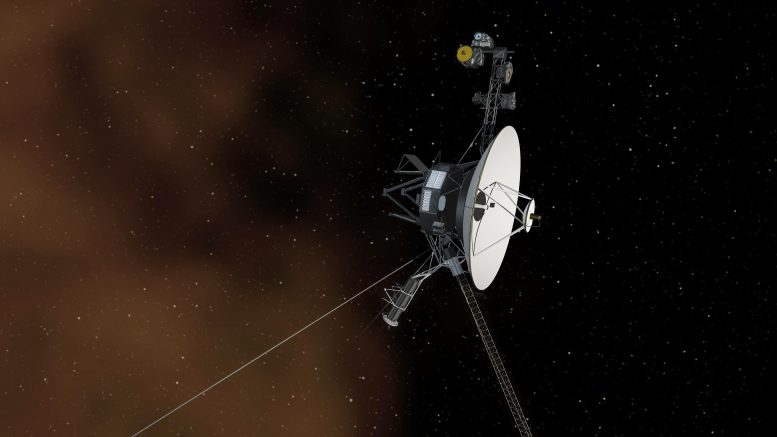
This artist’s concept depicts NASA’s Voyager 1 spacecraft entering interstellar space, or the space between stars. Following a computer glitch, Voyager 1 is back to transmitting scientific data, with further instrument recalibrations expected soon. Credit: NASA/JPL-Caltech
Voyager 1, after overcoming a computer issue, has resumed sending scientific data from two of its instruments, with plans to recalibrate the remaining two soon. This marks significant progress in restoring the spacecraft, which is over 15 billion miles from Earth and requires over 22 hours for communications to travel one way.
NASA ’s Voyager 1 has resumed returning science data from two of its four instruments for the first time since November 2023, when a computer issue arose with the spacecraft. The mission’s science instrument teams are now determining steps to recalibrate the remaining two instruments, which will likely occur in the coming weeks. The achievement marks significant progress toward restoring the spacecraft to normal operations.
Progress in Troubleshooting
In April, after five months of troubleshooting since the original computer issue, the mission was able to get the spacecraft to begin returning usable engineering data about the health and status of its onboard systems, including the science instruments. On May 17, the team sent commands to the 46-year-old spacecraft that enabled it to resume sending science data to Earth. With Voyager 1 located more than 15 billion miles (24 billion kilometers) from its home planet, it takes light over 22 1/2 hours to reach the spacecraft, and 22 1/2 hours for a signal to return to Earth. As a result, the team had to wait nearly two days to see if their commands were successful.
Instruments Begin Data Return
The plasma wave subsystem and magnetometer instrument are now returning usable science data. As part of the effort to restore Voyager 1 to normal operations, the mission is continuing work on the cosmic ray subsystem and low energy charged particle instrument. ( Six additional instruments aboard Voyager 1 are either no longer working or were turned off after the probe’s flyby of Saturn .)
Diagnosing Communication Issues
Normal operations were interrupted last year when Voyager 1 began sending a signal back to Earth that contained no science or engineering data. The team eventually determined the issue stemmed from a small portion of corrupted memory in the flight data subsystem, one of the spacecraft’s three computers. Among other things, this system is designed to package data from the science instruments as well as engineering data about the health and status of the spacecraft before that information is sent to Earth.
Longstanding Exploration Achievements
Launched in 1977 , Voyager 1 and its twin, Voyager 2, will celebrate 47 years of operations later this year. They are NASA’s longest-operating spacecraft as well as the first and only spacecraft to explore outside the heliosphere . Created by the Sun, this bubble of magnetic fields and solar wind pushes against the interstellar medium, an ocean of particles created by stars that have exploded elsewhere in the Milky Way galaxy. Both probes flew past Jupiter and Saturn, while Voyager 2 also flew past Uranus and Neptune .
More on SciTechDaily

Megalodon – The Largest Shark That Ever Lived – Could Eat Prey the Size of Entire Killer Whales
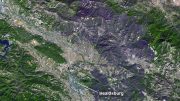
NASA’s Terra Satellite Images California’s Kincade Fire Burn Scar From Space
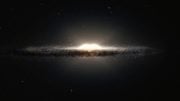
Detailed 3D Map Reveals Peanut Shape of Milky Way’s Inner Regions

Cutting-Edge Climate Research: NASA’s Final S-MODE Mission Studies the Ocean’s Surface
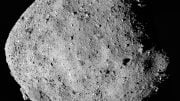
NASA’s OSIRIS-REx Spacecraft Discovers Water on Asteroid Bennu
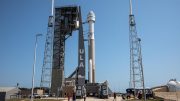
Boeing’s Orbital Flight Test-2 Starliner and Atlas V Rocket Roll Out To Launch Pad
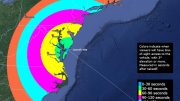
Antares’ Night Sky Spectacle: Watch the Next NASA Cargo Resupply Launch From Wallops

Preliminary Data Suggests Mixing COVID-19 Vaccines Increases Frequency of Adverse Reactions
7 comments on "fresh data from the cosmos: nasa’s voyager 1 resumes sending science data from 15 billion miles away".
I’m happy for Voyager! And the rest of us, despite hearing that all the previous data feeds (or the instruments) are still not up to speed.
Reading the JPL article, it has a likely misleading description on data from the instruments. Here is what NASA says:
“Voyager 1 has resumed returning science data from two of its four instruments for the first time since a computer issue arose with the spacecraft in November 2023. The mission’s science instrument teams are now determining steps to recalibrate the remaining two instruments, which will likely occur in the coming weeks. The achievement marks significant progress toward restoring the spacecraft to normal operations.”
Nope, strike that, I misread.
I have followed these 2 probes since they were launched and I believe it was and is money well spent and will benefit all of humanity now and long into the future. On a personal note I have spent 47 years enjoying the flow of information from the 2 probes. Thank you
Voyager is 47 years old and this won’t be the last “crisis” concerning hardware breakdowns. It’s amazing she has been so reliable and my hats off to the NASA team in keeping her operational. I’ve been following the Voyagers since their launch in 1977 and have really enjoyed their missions.
As a radio transmission a and satellite specialist and the NASA’s data about Voyager antennas, I think impossible the communication with any of Voyagers. The radio signal is too weak to get possible point the antennas in deep space about 23^9 km Voyager antennas: 3.7m Gain – 8.4 GHz = 49.2 dBi Gain – 2.2 GHz = 37.64 dBi Voyager 1: Downlink frequency: 8420.4321 MHz Uplink frequency: 2292.4231 MHz Voyager 2: Downlink frequency: 8420.4231 MHz Uplink frequency: 2113.3571 MHz Frequency (MHz) Voyager 1 : Coherent Non Coherent 2296.481481 2295.000000 8420.432097 8415.000000 Voyager 2: Coherent Non Coherent 2295.000000 2296.481481 8415.000000 8420.432097 Antennas on Earth: DSN-Deep Space Network Goldstone, California: 70m, 34m and 26m Madrid, Spain: 70m, 34m and 26m Canberra, Australia: 70m, 34m
But… Who am I for anybody that don’t know calc to believe?
Leave a comment Cancel reply
Email address is optional. If provided, your email will not be published or shared.
Save my name, email, and website in this browser for the next time I comment.
May 30, 2024
Voyager 1’s Revival Offers Inspiration for Everyone on Earth
Instruments may fail, but humanity’s most distant sentinel will keep exploring, and inspiring us all
By Saswato R. Das
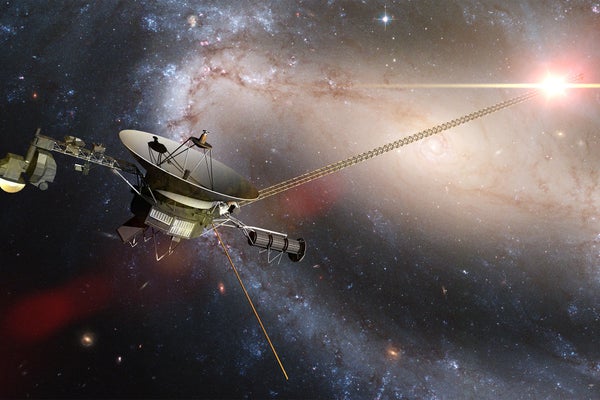
Artist's rendering of a Voyager spacecraft in deep space.
Dotted Zebra/Alamy Stock Photo
Amid April’s litany of bad news—war in Gaza, protests on American campuses, an impasse in Ukraine—a little uplift came for science buffs.
NASA has reestablished touch with Voyager 1 , the most distant thing built by our species, now hurtling through interstellar space far beyond the orbit of Pluto. The extraordinarily durable spacecraft had stopped transmitting data in November, but NASA engineers managed a very clever work-around, and it is sending data again. Now more than 15 billion miles away, Voyager 1 is the farthest human object, and continues to speed away from us at approximately 38,000 miles per hour.
Like an old car that continues to run, or an uncle blessed with an uncommonly long life, the robotic spacecraft is a super ager that goes on and on—and, in doing so, has captivated space buffs everywhere.
On supporting science journalism
If you're enjoying this article, consider supporting our award-winning journalism by subscribing . By purchasing a subscription you are helping to ensure the future of impactful stories about the discoveries and ideas shaping our world today.
Launched on September 5, 1977, the one-ton Voyager 1 was meant to chart the outer solar system, in particular the gas giant planets Jupiter and Saturn, and Saturn’s moon, Titan. Its twin, Voyager 2 , launched the same year, followed a different trajectory with a slightly different mission to explore the outer planets before heading to the solar system’s edge.
Those were NASA’s glory days. A few years earlier, NASA had successfully landed men on the moon—and won the space race for the U.S. NASA’s engineers were the envy of the world.
To get to Jupiter and Saturn, both Voyagers had to traverse the asteroid belt, which is full of rocks and debris orbiting the sun. They had to survive cosmic rays, intense radiation from Jupiter and other perils of space. But the two spacecraft made it without a hitch.
President Jimmy Carter held office when Voyager 1 was launched from Cape Canaveral; Elvis Presley had died just three weeks before; gas was about 60 cents a gallon; and, like now, the Middle East was in crisis, with Israeli Prime Minister Menachem Begin and Egyptian President Anwar Sadat trying to find peace.
Voyager 1 sent back spectacular photos of Jupiter and its giant red spot. It showed how dynamic the Jovian atmosphere was, with clouds and storms. It also took pictures of Jupiter’s moon Io, with its volcanoes, and Saturn’s moon Titan , which astronomers think has an atmosphere similar to the primordial Earth’s. The spacecraft discovered a thin ring around Jupiter and two new Jovian moons, which were named Thebe and Metis. On reaching Saturn, it discovered five new moons as well as a new ring.
And then Voyager 1 continued on its journey and sent images back from the edge of the solar system. Many of us remember the Pale Blue Dot , a haunting picture of the Earth it took on Feb 14, 1990, when it was a distance of 3.7 billion miles from the sun. The astronomer Carl Sagan wrote:
“There is perhaps no better demonstration of the folly of human conceits than this distant image of our tiny world. To me, it underscores our responsibility to deal more kindly with one another, and to preserve and cherish the pale blue dot, the only home we've ever known.”
By then Voyager 1 had long outlived its planetary mission but kept faithfully calling home as it traveled beyond the solar system into the realm of the stars. By 2012 Voyager 1 had reached the heliosphere , the farthest edge of the solar system. There, it penetrated the heliopause, where the solar wind ends, stopped by particles coming from the interstellar medium, the vast space between the stars. (Astronomers know that the space between the stars is not totally empty but permeated by a rarefied gas .)
From Voyager 1, scientists learned that the heliopause is quite dynamic and first measured the magnetic field of the Milky Way beyond the solar system. And its instruments kept sending data as it traveled through the interstellar medium.
On hearing that Voyager 1 had gone dark, I had checked in with Louis Lanzerotti , a former Bell Labs planetary scientist who did the calibrations for the Voyager 1 spacecraft and was a principal investigator on many experiments. He told me that a NASA manager in the 1970s had doubted that the spacecraft’s mechanical scan platform, which pointed instruments at targets, and very thin solid state detectors, which took those edge of the solar system readings, on the spacecraft would survive. They not only survived but worked flawlessly for all this time, Lanzerotti said, providing excellent data for decades. He was overjoyed on hearing the news that Voyager 1 was still alive.
Voyager 1 instruments have power until 2025 . After that, they will shut off, one by one. But there is nothing to stop the spacecraft as it speeds away from us in the vast emptiness of space.
Thousands of years from now, maybe when the human race has left this planet, Voyager 1, the tiny little spacecraft that could, will still continue its inexorable journey to the stars.
This is an opinion and analysis article, and the views expressed by the author or authors are not necessarily those of Scientific American.
10 Best Star Trek: Voyager Episodes, Ranked

Your changes have been saved
Email Is sent
Please verify your email address.
You’ve reached your account maximum for followed topics.
Everything about Star Trek: Voyager was a risk when the series debuted following the end of Star Trek: The Next Generation , an incredibly popular series. The flagship show of the nascent United Paramount Network, Captain Kathryn Janeway and her crew faced familiar struggles from fans. Their story, however, took the Star Trek universe to a new part of the galaxy. The Delta Quadrant hosted never-before-seen alien species and was the backyard of the Borg.
Through syndication and wide streaming access, Star Trek: Voyager is now regarded as a classic of this universe's second wave. Voyager finished its journey strong, and the addition of Seven of Nine -- a human drone rescued from the Borg collective -- changed the series for the better. Now in the third wave of the franchise, Seven of Nine is the captain of the USS Enterprise-G, and Janeway is now a Vice Admiral leading the young cadets of Star Trek: Prodigy . Below are the episodes that best showcase why Voyager is among Star Trek's most beloved series
10 'Distant Origin' Is the Kind of Social Allegory Star Trek Does Best
Voyager is caught up in a tale about scientific truth, immigration and acceptance, how did star trek: voyager become a tv series.
Star Trek: Voyager debuted after The Next Generation ended its historic run, but Captain Janeway's series was in development long before then.
The only episode on this list before Seven of Nine joined the crew, "Distant Origin" is representative of what Star Trek does best . It's a high-concept story about scientific exploration and the ways entrenched powers oppress the truth and those who seem "lesser" than them . The Voth are a superior race of intelligent beings that evolved tens of millions of years in Earth's past and took the stars.
The titular theory threatens the social order of the Voth, and the idea that they have a right to oppress others because they are "the first race" in their sector of space. Ironically, the episode spends much of its time away from the USS Voyager. It's not really their story, but rather the story of the Voth scientist facing punishment for violating "doctrine."
9 'Dark Frontier' Reveals Seven of Nine's Human Past and Importance to the Borg
This episode ties voyager to first contact and the next generation.
A feature-length two-part episode, "Dark Frontier" brings the Borg Queen to television for the first time since the character was created for Star Trek: First Contact . It also reveals how Annika Hansen and her parents came to be assimilated by the Borg. Part-heist story and part "mythology episode," which gives viewers a courtside view to how the Borg assimilate a species.
The USS Voyager plans to steal some Borg technology to help them get to Earth more quickly, but it's trap to recapture Seven of Nine. The Borg Queen reveals that Seven of Nine was "allowed" to leave the collective, and her recapture is meant to make her the human face of the Borg invasion of Earth, just as Locutus (Jean-Luc Picard) and Vox (Jack Crusher) were meant to be. In rescuing Seven of Nine, Captain Kathryn Janeway proves herself to be the Borg's biggest threat .
8 'Drone' Is a Perfect Blend of Star Trek Weirdness and Character Study
A high-concept voyager episode with a deeply emotional ending.
In "Drone," the holographic Doctor and Seven of Nine have a baby, of sorts. Originally bound to sickbay and the holodecks, the Doctor was given a 29th Century mobile emitter by Henry Starling. A transporter accident blends Borg "nanoprobes" with this technology creating a 29th Century Borg drone, just without a collective. He names himself "One," becoming something like a son to Seven of Nine.
One accidentally signals the Borg collective, which shows up to assimilate him and the USS Voyager. One is curious about his people, yet he's fully an individual . First, he helps the crew fight the Borg cube, but even his 29th Century know-how can't match the cube's raw firepower. He sacrifices himself in truly epic fashion, saving the ship but breaking Seven of Nine's heart .
7 'Endgame' Is the Epic Series Finale for Voyager and the Borg
Janeway brings the crew home and defeats star trek's worst enemy, star trek: voyager actor weighs in on controversial tuvix debate.
Star Trek: Voyager's Tuvix actor Tom Wright shares his opinion on whether Janeway made the right decision about his character's fate.
While everyone from fans to some of the cast lament the series finale of Star Trek: Voyager didn't show the ship actually arriving on Earth, it's still a fantastic finale. It begins many years after the previous episode, when the USS Voyager does arrive on Earth. Now a Vice Admiral, Janeway travels back in time with a plan to bring the ship and immobilize the Borg. All it will cost her is her life.
The beginning of the finale shows a version of the crew's future, though not everyone made it to Earth. The Elder Janeway's plan is ambitious and takes the ship right into the heart of the Borg society. While her younger counterpart gets her ship home, the elder Janeway has a final showdown with the Borg Queen. "Endgame" is full of spectacle appropriate for a series finale, while not sacrificing attention on the characters fans loved .
6 'Year of Hell' Is an Epic Two-Part Struggle for Survival
A year-long episode of star trek: voyager was almost a whole season.
The "Year of Hell" is a two-part episode that, according to Star Trek Voyager: A Celebration , could've lasted for an entire season. The episode centers on a new species called the Kremin, who developed a "timeship" that could erase entire civilizations from history. The captain and lead scientist, Annorax , continues these temporal incursions and sets his sights on the USS Voyager.
The two-part episode takes place over an entire year, with the USS Voyager and the Krenim engaging in a running war. The ship is damaged, the crew is battered and demoralized. The resolution resets the series' status quo. Had the fallout from this taken a full season, the show might have gotten too dark. This two-part epic is just enough "hell" to make this episode a classic instead of "the one where the season started to go downhill." The Krenim and the idea of the "Year of Hell" was mentioned in Season 3's "Before and After," when Kes visited a possible future.
5 'Timeless' Is About the Death and Resurrection of the USS Voyager
The survivors of the uss voyager break the prime directive to rewrite history.
Time travel is a Star Trek staple , and Voyager featured a lot of it. In "Timeless," select members of the crew survive after the USS Voyager is destroyed. The episode was directed by LeVar Burton who also appeared as Captain Geordi La Forge from the alternate future. As the surviving crew tries to change the past, La Forge has to stop them from violating the "Temporal Prime Directive."
Along with being a dark look at the future, the episode is emotionally heavy, especially for Chakotay and Harry Kim. The latter blames himself for the accident that destroyed the ship. He is determined to fix that mistake. Even though he's successful, the episode ends on a down note as the elder Kim sends a message to his younger self.
4 'Message In a Bottle' Brings Voyager One Step Closer to Home
The emergency medical holograms prove their mettle as starfleet officers, star trek: prodigy is the last hope for janeway and chakotay shippers.
Star Trek: Prodigy brought Voyager characters Kathryn Janeway and Chakotay back into their story and there is a chance for the romance fans never got.
The Romulans appear in "Message In a Bottle," one of the rare times a classic Star Trek alien species appears in Voyager other than the crew. The ship discovers a massive sensor array, and Seven of Nine sends the Doctor to another Starfleet vessel on the edge of Federation space. The array is the bottle, and he is the message. However, the ship is experimental and has been overtaken by Romulans.
The Doctor meets the Mark II version of the Emergency Medical Hologram used by Starfleet, and the irascible pair have to take on the Romulans. Along with being a thrilling episode in its own right, "Message In a Bottle" was important to the overall story. It's the first time the USS Voyager is able to make contact with Starfleet, letting them know the ship was not destroyed .
3 'Living Witness' Is Unlike Any Other Star Trek Episode
The closest the uss voyager ever got to the 'mirror universe'.
Another Doctor-heavy episode, "Living Witness" is a truly unique premise, not just for Voyager but Star Trek itself. Much of the episode is set far in the future from the 24th Century, in a society where the USS Voyager, Starfleet and Captain Janeway have become myth. A copy of the Doctor's program is discovered, and a researcher at the museum reactivates him.
The holographic recreations of the USS Voyager are like Mirror Universe versions of the characters fans know. As the Doctor tries to set the record straight, it causes social upheaval in the society. Ultimately, he urges the researcher to deactivate him and maintain peace on his planet, at the cost of the truth . Though, an even further future ending scene shows the truth eventually came out.
2 'Scorpion' Represents an Ending and a Beginning for Voyager
These episodes introdce the borg and seven of nine, star trek: prodigy's connection to voyager, explained.
Star Trek: Prodigy is a new series with new characters in the universe, but the series is directly connected to Voyager through characters and ships.
The end of Star Trek: Voyager Season 3 and start of Season 4 began the ship's frequent conflicts with the Borg. The second part of the two-part episode also introduces Seven of Nine, as Captain Janeway makes an alliance with the Borg . They encounter a new alien, species 8472 from a dimension of "fluidic space" with no other lifeforms. They are immune to assimilation.
The first episode cold open is short but powerful. A pair of Borg cubes descend on the unseen species 8472 and are destroyed. "Scorpion" is as consequential to Voyager as the classic Season 3 to 4 " Best of Both Worlds " was to The Next Generation . Unlike the USS Enterprise, which only had to deal with a single Borg cube, the USS Voyager was in the heart of Borg space.
1 'Blink of an Eye' Is a Classic Star Trek Episode with a Unique Concept
The top-rated star trek: voyager episode encompasses everything the franchise does best.
The USS Voyager finds itself stuck in the orbit of a planet that has a strange time variance, due to a heavy concentration of "chronaton particles." While the ship spends less than a week in this predicament, the time differential means the ship is viewed in the sky by the planet's indigenous population for a millennia. The "skyship" is the subject of myth, religion, pop culture and serves as an impetus for scientific advancement.
Because of the Prime Directive , the crew avoids making contact with the population, even though the presence of the ship causes frequent planetwide earthquakes. However, as the society advances, explorers from the planet come to the ship. It's a classic Star Trek episode despite being so unique. Just like "Distant Origin," it deals with the idea of scientific exploration, respect for other cultures or societies, and the propensity for any species to turn to violence when faced with the unknown .
Star Trek: Voyager is available to own on Blu-ray, DVD, digital and streams on Paramount+ and Pluto TV.
Star Trek Voyager
Pulled to the far side of the galaxy, where the Federation is seventy-five years away at maximum warp speed, a Starfleet ship must cooperate with Maquis rebels to find a way home.

- The Contents
- The Making of
- Where Are They Now
- Frequently Asked Questions
- Q & A with Ed Stone
golden record
Where are they now.
- frequently asked questions
- Q&A with Ed Stone
The Voyager Planetary Mission
The twin spacecraft Voyager 1 and Voyager 2 were launched by NASA in separate months in the summer of 1977 from Cape Canaveral, Florida. As originally designed, the Voyagers were to conduct closeup studies of Jupiter and Saturn, Saturn's rings, and the larger moons of the two planets.
To accomplish their two-planet mission, the spacecraft were built to last five years. But as the mission went on, and with the successful achievement of all its objectives, the additional flybys of the two outermost giant planets, Uranus and Neptune, proved possible -- and irresistible to mission scientists and engineers at the Voyagers' home at the Jet Propulsion Laboratory in Pasadena, California.
As the spacecraft flew across the solar system, remote-control reprogramming was used to endow the Voyagers with greater capabilities than they possessed when they left the Earth. Their two-planet mission became four. Their five-year lifetimes stretched to 12 and more.
Eventually, between them, Voyager 1 and 2 would explore all the giant outer planets of our solar system, 48 of their moons, and the unique systems of rings and magnetic fields those planets possess.
Had the Voyager mission ended after the Jupiter and Saturn flybys alone, it still would have provided the material to rewrite astronomy textbooks. But having doubled their already ambitious itineraries, the Voyagers returned to Earth information over the years that has revolutionized the science of planetary astronomy, helping to resolve key questions while raising intriguing new ones about the origin and evolution of the planets in our solar system.
History of the Voyager Mission
The Voyager mission was designed to take advantage of a rare geometric arrangement of the outer planets in the late 1970s and the 1980s which allowed for a four-planet tour for a minimum of propellant and trip time. This layout of Jupiter, Saturn, Uranus and Neptune, which occurs about every 175 years, allows a spacecraft on a particular flight path to swing from one planet to the next without the need for large onboard propulsion systems. The flyby of each planet bends the spacecraft's flight path and increases its velocity enough to deliver it to the next destination. Using this "gravity assist" technique, first demonstrated with NASA's Mariner 10 Venus/Mercury mission in 1973-74, the flight time to Neptune was reduced from 30 years to 12.
While the four-planet mission was known to be possible, it was deemed to be too expensive to build a spacecraft that could go the distance, carry the instruments needed and last long enough to accomplish such a long mission. Thus, the Voyagers were funded to conduct intensive flyby studies of Jupiter and Saturn only. More than 10,000 trajectories were studied before choosing the two that would allow close flybys of Jupiter and its large moon Io, and Saturn and its large moon Titan; the chosen flight path for Voyager 2 also preserved the option to continue on to Uranus and Neptune.
From the NASA Kennedy Space Center at Cape Canaveral, Florida, Voyager 2 was launched first, on August 20, 1977; Voyager 1 was launched on a faster, shorter trajectory on September 5, 1977. Both spacecraft were delivered to space aboard Titan-Centaur expendable rockets.
The prime Voyager mission to Jupiter and Saturn brought Voyager 1 to Jupiter on March 5, 1979, and Saturn on November 12, 1980, followed by Voyager 2 to Jupiter on July 9, 1979, and Saturn on August 25, 1981.
Voyager 1's trajectory, designed to send the spacecraft closely past the large moon Titan and behind Saturn's rings, bent the spacecraft's path inexorably northward out of the ecliptic plane -- the plane in which most of the planets orbit the Sun. Voyager 2 was aimed to fly by Saturn at a point that would automatically send the spacecraft in the direction of Uranus.
After Voyager 2's successful Saturn encounter, it was shown that Voyager 2 would likely be able to fly on to Uranus with all instruments operating. NASA provided additional funding to continue operating the two spacecraft and authorized JPL to conduct a Uranus flyby. Subsequently, NASA also authorized the Neptune leg of the mission, which was renamed the Voyager Neptune Interstellar Mission.
Voyager 2 encountered Uranus on January 24, 1986, returning detailed photos and other data on the planet, its moons, magnetic field and dark rings. Voyager 1, meanwhile, continues to press outward, conducting studies of interplanetary space. Eventually, its instruments may be the first of any spacecraft to sense the heliopause -- the boundary between the end of the Sun's magnetic influence and the beginning of interstellar space. (Voyager 1 entered Interstellar Space on August 25, 2012.)
Following Voyager 2's closest approach to Neptune on August 25, 1989, the spacecraft flew southward, below the ecliptic plane and onto a course that will take it, too, to interstellar space. Reflecting the Voyagers' new transplanetary destinations, the project is now known as the Voyager Interstellar Mission.
Voyager 1 is now leaving the solar system, rising above the ecliptic plane at an angle of about 35 degrees at a rate of about 520 million kilometers (about 320 million miles) a year. Voyager 2 is also headed out of the solar system, diving below the ecliptic plane at an angle of about 48 degrees and a rate of about 470 million kilometers (about 290 million miles) a year.
Both spacecraft will continue to study ultraviolet sources among the stars, and the fields and particles instruments aboard the Voyagers will continue to search for the boundary between the Sun's influence and interstellar space. The Voyagers are expected to return valuable data for two or three more decades. Communications will be maintained until the Voyagers' nuclear power sources can no longer supply enough electrical energy to power critical subsystems.
The cost of the Voyager 1 and 2 missions -- including launch, mission operations from launch through the Neptune encounter and the spacecraft's nuclear batteries (provided by the Department of Energy) -- is $865 million. NASA budgeted an additional $30 million to fund the Voyager Interstellar Mission for two years following the Neptune encounter.
Voyagers 1 and 2 are identical spacecraft. Each is equipped with instruments to conduct 10 different experiments. The instruments include television cameras, infrared and ultraviolet sensors, magnetometers, plasma detectors, and cosmic-ray and charged-particle sensors. In addition, the spacecraft radio is used to conduct experiments.
The Voyagers travel too far from the Sun to use solar panels; instead, they were equipped with power sources called radioisotope thermoelectric generators (RTGs). These devices, used on other deep space missions, convert the heat produced from the natural radioactive decay of plutonium into electricity to power the spacecraft instruments, computers, radio and other systems.
The spacecraft are controlled and their data returned through the Deep Space Network (DSN), a global spacecraft tracking system operated by JPL for NASA. DSN antenna complexes are located in California's Mojave Desert; near Madrid, Spain; and in Tidbinbilla, near Canberra, Australia.
The Voyager project manager for the Interstellar Mission is George P. Textor of JPL. The Voyager project scientist is Dr. Edward C. Stone of the California Institute of Technology. The assistant project scientist for the Jupiter flyby was Dr. Arthur L. Lane, followed by Dr. Ellis D. Miner for the Saturn, Uranus and Neptune encounters. Both are with JPL.
JUPITER Voyager 1 made its closest approach to Jupiter on March 5, 1979, and Voyager 2 followed with its closest approach occurring on July 9, 1979. The first spacecraft flew within 277,400 kilometers (172,368 miles) of the planet's cloud tops, and Voyager 2 came within 650,180 kilometers (404,003 miles).
Jupiter is the largest planet in the solar system, composed mainly of hydrogen and helium, with small amounts of methane, ammonia, water vapor, traces of other compounds and a core of melted rock and ice. Colorful latitudinal bands and atmospheric clouds and storms illustrate Jupiter's dynamic weather system. The giant planet is now known to possess 16 moons. The planet completes one orbit of the Sun each 11.8 years and its day is 9 hours, 55 minutes.
Although astronomers had studied Jupiter through telescopes on Earth for centuries, scientists were surprised by many of the Voyager findings.
The Great Red Spot was revealed as a complex storm moving in a counterclockwise direction. An array of other smaller storms and eddies were found throughout the banded clouds.
Discovery of active volcanism on the satellite Io was easily the greatest unexpected discovery at Jupiter. It was the first time active volcanoes had been seen on another body in the solar system. Together, the Voyagers observed the eruption of nine volcanoes on Io, and there is evidence that other eruptions occurred between the Voyager encounters.
Plumes from the volcanoes extend to more than 300 kilometers (190 miles) above the surface. The Voyagers observed material ejected at velocities up to a kilometer per second.
Io's volcanoes are apparently due to heating of the satellite by tidal pumping. Io is perturbed in its orbit by Europa and Ganymede, two other large satellites nearby, then pulled back again into its regular orbit by Jupiter. This tug-of-war results in tidal bulging as great as 100 meters (330 feet) on Io's surface, compared with typical tidal bulges on Earth of one meter (three feet).
It appears that volcanism on Io affects the entire jovian system, in that it is the primary source of matter that pervades Jupiter's magnetosphere -- the region of space surrounding the planet influenced by the jovian magnetic field. Sulfur, oxygen and sodium, apparently erupted by Io's many volcanoes and sputtered off the surface by impact of high-energy particles, were detected as far away as the outer edge of the magnetosphere millions of miles from the planet itself.
Europa displayed a large number of intersecting linear features in the low-resolution photos from Voyager 1. At first, scientists believed the features might be deep cracks, caused by crustal rifting or tectonic processes. The closer high-resolution photos from Voyager 2, however, left scientists puzzled: The features were so lacking in topographic relief that as one scientist described them, they "might have been painted on with a felt marker." There is a possibility that Europa may be internally active due to tidal heating at a level one-tenth or less than that of Io. Europa is thought to have a thin crust (less than 30 kilometers or 18 miles thick) of water ice, possibly floating on a 50-kilometer-deep (30-mile) ocean.
Ganymede turned out to be the largest moon in the solar system, with a diameter measuring 5,276 kilometers (3,280 miles). It showed two distinct types of terrain -- cratered and grooved -- suggesting to scientists that Ganymede's entire icy crust has been under tension from global tectonic processes.
Callisto has a very old, heavily cratered crust showing remnant rings of enormous impact craters. The largest craters have apparently been erased by the flow of the icy crust over geologic time. Almost no topographic relief is apparent in the ghost remnants of the immense impact basins, identifiable only by their light color and the surrounding subdued rings of concentric ridges.
A faint, dusty ring of material was found around Jupiter. Its outer edge is 129,000 kilometers (80,000 miles) from the center of the planet, and it extends inward about 30,000 kilometers (18,000 miles).
Two new, small satellites, Adrastea and Metis, were found orbiting just outside the ring. A third new satellite, Thebe, was discovered between the orbits of Amalthea and Io.
Jupiter's rings and moons exist within an intense radiation belt of electrons and ions trapped in the planet's magnetic field. These particles and fields comprise the jovian magnetosphere, or magnetic environment, which extends three to seven million kilometers toward the Sun, and stretches in a windsock shape at least as far as Saturn's orbit -- a distance of 750 million kilometers (460 million miles).
As the magnetosphere rotates with Jupiter, it sweeps past Io and strips away about 1,000 kilograms (one ton) of material per second. The material forms a torus, a doughnut-shaped cloud of ions that glow in the ultraviolet. Some of the torus's heavy ions migrate outward, and their pressure inflates the Jovian magnetosphere, while the more energetic sulfur and oxygen ions fall along the magnetic field into the planet's atmosphere, resulting in auroras.
Io acts as an electrical generator as it moves through Jupiter's magnetic field, developing 400,000 volts across its diameter and generating an electric current of 3 million amperes that flows along the magnetic field to the planet's ionosphere.
SATURN The Voyager 1 and 2 Saturn flybys occurred nine months apart, with the closest approaches falling on November 12 and August 25, 1981. Voyager 1 flew within 64,200 kilometers (40,000 miles) of the cloud tops, while Voyager 2 came within 41,000 kilometers (26,000 miles).
Saturn is the second largest planet in the solar system. It takes 29.5 Earth years to complete one orbit of the Sun, and its day was clocked at 10 hours, 39 minutes. Saturn is known to have at least 17 moons and a complex ring system. Like Jupiter, Saturn is mostly hydrogen and helium. Its hazy yellow hue was found to be marked by broad atmospheric banding similar to but much fainter than that found on Jupiter. Close scrutiny by Voyager's imaging systems revealed long-lived ovals and other atmospheric features generally smaller than those on Jupiter.
Perhaps the greatest surprises and the most puzzles were found by the Voyagers in Saturn's rings. It is thought that the rings formed from larger moons that were shattered by impacts of comets and meteoroids. The resulting dust and boulder- to house-size particles have accumulated in a broad plane around the planet varying in density.
The irregular shapes of Saturn's eight smallest moons indicates that they too are fragments of larger bodies. Unexpected structure such as kinks and spokes were found in addition to thin rings and broad, diffuse rings not observed from Earth. Much of the elaborate structure of some of the rings is due to the gravitational effects of nearby satellites. This phenomenon is most obviously demonstrated by the relationship between the F-ring and two small moons that "shepherd" the ring material. The variation in the separation of the moons from the ring may the ring's kinked appearance. Shepherding moons were also found by Voyager 2 at Uranus.
Radial, spoke-like features in the broad B-ring were found by the Voyagers. The features are believed to be composed of fine, dust-size particles. The spokes were observed to form and dissipate in time-lapse images taken by the Voyagers. While electrostatic charging may create spokes by levitating dust particles above the ring, the exact cause of the formation of the spokes is not well understood.
Winds blow at extremely high speeds on Saturn -- up to 1,800 kilometers per hour (1,100 miles per hour). Their primarily easterly direction indicates that the winds are not confined to the top cloud layer but must extend at least 2,000 kilometers (1,200 miles) downward into the atmosphere. The characteristic temperature of the atmosphere is 95 kelvins.
Saturn holds a wide assortment of satellites in its orbit, ranging from Phoebe, a small moon that travels in a retrograde orbit and is probably a captured asteroid, to Titan, the planet-sized moon with a thick nitrogen-methane atmosphere. Titan's surface temperature and pressure are 94 kelvins (-292 Fahrenheit) and 1.5 atmospheres. Photochemistry converts some atmospheric methane to other organic molecules, such as ethane, that is thought to accumulate in lakes or oceans. Other more complex hydrocarbons form the haze particles that eventually fall to the surface, coating it with a thick layer of organic matter. The chemistry in Titan's atmosphere may strongly resemble that which occurred on Earth before life evolved.
The most active surface of any moon seen in the Saturn system was that of Enceladus. The bright surface of this moon, marked by faults and valleys, showed evidence of tectonically induced change. Voyager 1 found the moon Mimas scarred with a crater so huge that the impact that caused it nearly broke the satellite apart.
Saturn's magnetic field is smaller than Jupiter's, extending only one or two million kilometers. The axis of the field is almost perfectly aligned with the rotation axis of the planet.
URANUS In its first solo planetary flyby, Voyager 2 made its closest approach to Uranus on January 24, 1986, coming within 81,500 kilometers (50,600 miles) of the planet's cloud tops.
Uranus is the third largest planet in the solar system. It orbits the Sun at a distance of about 2.8 billion kilometers (1.7 billion miles) and completes one orbit every 84 years. The length of a day on Uranus as measured by Voyager 2 is 17 hours, 14 minutes.
Uranus is distinguished by the fact that it is tipped on its side. Its unusual position is thought to be the result of a collision with a planet-sized body early in the solar system's history. Given its odd orientation, with its polar regions exposed to sunlight or darkness for long periods, scientists were not sure what to expect at Uranus.
Voyager 2 found that one of the most striking influences of this sideways position is its effect on the tail of the magnetic field, which is itself tilted 60 degrees from the planet's axis of rotation. The magnetotail was shown to be twisted by the planet's rotation into a long corkscrew shape behind the planet.
The presence of a magnetic field at Uranus was not known until Voyager's arrival. The intensity of the field is roughly comparable to that of Earth's, though it varies much more from point to point because of its large offset from the center of Uranus. The peculiar orientation of the magnetic field suggests that the field is generated at an intermediate depth in the interior where the pressure is high enough for water to become electrically conducting.
Radiation belts at Uranus were found to be of an intensity similar to those at Saturn. The intensity of radiation within the belts is such that irradiation would quickly darken (within 100,000 years) any methane trapped in the icy surfaces of the inner moons and ring particles. This may have contributed to the darkened surfaces of the moons and ring particles, which are almost uniformly gray in color.
A high layer of haze was detected around the sunlit pole, which also was found to radiate large amounts of ultraviolet light, a phenomenon dubbed "dayglow." The average temperature is about 60 kelvins (-350 degrees Fahrenheit). Surprisingly, the illuminated and dark poles, and most of the planet, show nearly the same temperature at the cloud tops.
Voyager found 10 new moons, bringing the total number to 15. Most of the new moons are small, with the largest measuring about 150 kilometers (about 90 miles) in diameter.
The moon Miranda, innermost of the five large moons, was revealed to be one of the strangest bodies yet seen in the solar system. Detailed images from Voyager's flyby of the moon showed huge fault canyons as deep as 20 kilometers (12 miles), terraced layers, and a mixture of old and young surfaces. One theory holds that Miranda may be a reaggregration of material from an earlier time when the moon was fractured by an violent impact.
The five large moons appear to be ice-rock conglomerates like the satellites of Saturn. Titania is marked by huge fault systems and canyons indicating some degree of geologic, probably tectonic, activity in its history. Ariel has the brightest and possibly youngest surface of all the Uranian moons and also appears to have undergone geologic activity that led to many fault valleys and what seem to be extensive flows of icy material. Little geologic activity has occurred on Umbriel or Oberon, judging by their old and dark surfaces.
All nine previously known rings were studied by the spacecraft and showed the Uranian rings to be distinctly different from those at Jupiter and Saturn. The ring system may be relatively young and did not form at the same time as Uranus. Particles that make up the rings may be remnants of a moon that was broken by a high-velocity impact or torn up by gravitational effects.
NEPTUNE When Voyager flew within 5,000 kilometers (3,000 miles) of Neptune on August 25, 1989, the planet was the most distant member of the solar system from the Sun. (Pluto once again will become most distant in 1999.)
Neptune orbits the Sun every 165 years. It is the smallest of our solar system's gas giants. Neptune is now known to have eight moons, six of which were found by Voyager. The length of a Neptunian day has been determined to be 16 hours, 6.7 minutes.
Even though Neptune receives only three percent as much sunlight as Jupiter does, it is a dynamic planet and surprisingly showed several large, dark spots reminiscent of Jupiter's hurricane-like storms. The largest spot, dubbed the Great Dark Spot, is about the size of Earth and is similar to the Great Red Spot on Jupiter. A small, irregularly shaped, eastward-moving cloud was observed "scooting" around Neptune every 16 hours or so; this "scooter," as Voyager scientists called it, could be a cloud plume rising above a deeper cloud deck.
Long, bright clouds, similar to cirrus clouds on Earth, were seen high in Neptune's atmosphere. At low northern latitudes, Voyager captured images of cloud streaks casting their shadows on cloud decks below.
The strongest winds on any planet were measured on Neptune. Most of the winds there blow westward, or opposite to the rotation of the planet. Near the Great Dark Spot, winds blow up to 2,000 kilometers (1,200 miles) an hour.
The magnetic field of Neptune, like that of Uranus, turned out to be highly tilted -- 47 degrees from the rotation axis and offset at least 0.55 radii (about 13,500 kilometers or 8,500 miles) from the physical center. Comparing the magnetic fields of the two planets, scientists think the extreme orientation may be characteristic of flows in the interiors of both Uranus and Neptune -- and not the result in Uranus's case of that planet's sideways orientation, or of any possible field reversals at either planet. Voyager's studies of radio waves caused by the magnetic field revealed the length of a Neptunian day. The spacecraft also detected auroras, but much weaker than those on Earth and other planets.
Triton, the largest of the moons of Neptune, was shown to be not only the most intriguing satellite of the Neptunian system, but one of the most interesting in all the solar system. It shows evidence of a remarkable geologic history, and Voyager 2 images showed active geyser-like eruptions spewing invisible nitrogen gas and dark dust particles several kilometers into the tenuous atmosphere. Triton's relatively high density and retrograde orbit offer strong evidence that Triton is not an original member of Neptune's family but is a captured object. If that is the case, tidal heating could have melted Triton in its originally eccentric orbit, and the moon might even have been liquid for as long as one billion years after its capture by Neptune.
An extremely thin atmosphere extends about 800 kilometer (500 miles) above Triton's surface. Nitrogen ice particles may form thin clouds a few kilometers above the surface. The atmospheric pressure at the surface is about 14 microbars, 1/70,000th the surface pressure on Earth. The surface temperature is about 38 kelvins (-391 degrees Fahrenheit) the coldest temperature of any body known in the solar system.
The new moons found at Neptune by Voyager are all small and remain close to Neptune's equatorial plane. Names for the new moons were selected from mythology's water deities by the International Astronomical Union, they are: Naiad, Thalassa, Despina, Galatea, Larissa, Proteus.
Voyager 2 solved many of the questions scientists had about Neptune's rings. Searches for "ring arcs," or partial rings, showed that Neptune's rings actually are complete, but are so diffuse and the material in them so fine that they could not be fully resolved from Earth. From the outermost in, the rings have been designated Adams, Plateau, Le Verrier and Galle.
Interstellar Mission
The spacecraft are continuing to return data about interplanetary space and some of our stellar neighbors near the edges of the Milky Way.
As the Voyagers cruise gracefully in the solar wind, their fields, particles and waves instruments are studying the space around them. In May 1993, scientists concluded that the plasma wave experiment was picking up radio emissions that originate at the heliopause -- the outer edge of our solar system.
The heliopause is the outermost boundary of the solar wind, where the interstellar medium restricts the outward flow of the solar wind and confines it within a magnetic bubble called the heliosphere. The solar wind is made up of electrically charged atomic particles, composed primarily of ionized hydrogen, that stream outward from the Sun.
Exactly where the heliopause is has been one of the great unanswered questions in space physics. By studying the radio emissions, scientists now theorize the heliopause exists some 90 to 120 astronomical units (AU) from the Sun. (One AU is equal to 150 million kilometers (93 million miles), or the distance from the Earth to the Sun.
The Voyagers have also become space-based ultraviolet observatories and their unique location in the universe gives astronomers the best vantage point they have ever had for looking at celestial objects that emit ultraviolet radiation.
The Ultraviolet Spectrometer (UVS) is the only experiment on the scan platform that is still functioning. The scan platform is parked at a fixed position and is not being articulated. The Infrared Spectrometer and Radiometer (IRIS) heater was turned off to save power on Voyager 1 on December 7, 2011. On January 21, 2014 the Scan Platform Supplemental Heater was also turned off to conserve power. The IRIS heater and the Scan Platform Heater were used to keep UVS warm. The UVS temperature has dropped to below the measurement limits of the sensor; however, UVS is still operating. The scientist expect to continue to receive data from the UVS until 2016, at which time the instrument will be turned off to save power.
Yet there are several other fields and particle instruments that can continue to send back data as long as the spacecraft stay alive. They include: the cosmic ray subsystem, the low-energy charge particle instrument, the magnetometer, the plasma subsystem, the plasma wave subsystem and the planetary radio astronomy instrument. Barring any catastrophic events, JPL should be able to retrieve this information for at least the next 20 and perhaps even the next 30 years.
Screen Rant
Star trek: voyager created its own version of wandavision almost 30 years ago.

Your changes have been saved
Email Is sent
Please verify your email address.
You’ve reached your account maximum for followed topics.
Star Trek: Voyager Cast & Character Guide
The bear season 3 just revealed its replacement for last year’s most shocking episode, discovery’s ending sets a star trek record & creates 2 new admirals.
- Star Trek: Voyager had a version of WandaVision in an episode from season 3.
- Voyager's finale "Endgame" also shares similarities with Avengers: Endgame in plot and villains.
- Both Star Trek: Voyager and the MCU have more similarities than are initially apparent.
Star Trek: Voyager did a version of WandaVision nearly 30 years before the Marvel Cinematic Universe. Although Star Trek and the MCU are both huge franchises, there generally aren't a lot of similarities between the two. The MCU took a decidedly science fiction lean during its first three phases but in a different way than the Star Trek timeline , which depicts a utopian vision of the future while the MCU runs concurrently with the present. However, one MCU show that did seemingly borrow a story idea from Star Trek was WandaVision .
Kicking off Phase Four of the MCU in 2021, WandaVision followed Wanda Maximoff (Elizabeth Olsen) and Vision (Paul Bettany) living a seemingly idyllic sitcom-inspired life in small-town New Jersey. Through a slow build-up, the show revealed that in her grief over Vision's death, Wanda had used her Chaos Magic to create their marital bliss, inadvertently enslaving the entire town of Westview in the process to act as characters in her fantasy. Although not a direct copy, this premise is a lot like a season 3 episode of Voyager involving the Doctor (Robert Picardo) .
In its seven seasons, Star Trek: Voyager introduced many new faces to the Trek universe. Here is a breakdown of the show's main cast and characters.
Voyager’s Season 3 Episode “Real Life” Is Like Star Trek’s Version Of WandaVision
"real life" has a lot of similarities to the mcu show.
Voyager season 3, episode 22, "Real Life" bears a lot of similarities to WandaVision in premise. Although there was no mystery about how the Doctor's fantasy in "Real Life" existed thanks to Star Trek 's holodeck , both he and Wanda created an idealized version of family life for themselves to experience something they felt like they couldn't have any other way . Additionally, the sitcom aspect of WandaVision and how it progresses through different eras is also loosely reflected in "Real Life." The quote from Robert Picardo below talking about the episode's premise unintentionally sums up these similarities well:
"The first act of that script is like a '70s sitcom. It's like The Partridge Family or The Brady Bunch. Everything about it is like an old sitcom. Then the second act – after The Doctor's family program has been randomized, so that everybody's not so perfect in their behavior – became like a '90s sitcom, where everybody's dissing dad. Then, suddenly, it took this odd turn and became very dramatic. And the last part of the show is like an ER episode, where a child is going to die. It starts out so silly and so ridiculous, then becomes quite touching by the end."
Of course, WandaVision is not a one-to-one copy of "Real Life," and likely wasn't directly inspired by the Star Trek episode. The show relies much more heavily on the question of why Westview exists and has a clear villain whereas "Real Life" does not. The theme of grief and loss is also much more present throughout. However, both "Real Life" and WandaVision end up giving their protagonist a greater understanding of their own humanity and the emotional/mental trials they could withstand. Interestingly, "Real Life" isn't even the only Voyager episode with a connection to the MCU.
Star Trek: Voyager's "Endgame" Beat Avengers By 28 Years
Voyager also did "endgame" before the avengers franchise.
Similarly to the explosive final film of the MCU's Phase Three, Voyager ’s series finale was also called “Endgame.” The chess term is a fairly popular title for finales, but the similarities between "Endgame" and Avengers: Endgame don't end there. Both stories involved time travel to reverse - or in Voyager ’s case prevent - the deaths of several important characters . In the MCU, the scale was much larger thanks to the Blip, but Admiral Janeway's (Kate Mulgrew) plan to prevent the deaths of Seven of Nine (Jeri Ryan) and Chakotay (Robert Beltran) in Voyager was just as important.
Another big similarity between the two projects was their respective villains. Although their motivations differed widely, Thanos (Josh Brolin) and the Borg Queen (Alice Krige) are fairly comparable big bads in terms of their relative importance to their respective franchises. Thanos is perhaps the most substantial villain the MCU has created to date, and the Borg Queen is the head of Star Trek 's biggest enemy. Despite many differences, Star Trek: Voyager and the MCU are a lot more similar than they might appear at first glance.
Source: Braving the Unknown: Season Three , Voyager season 3 DVD special features.
Star Trek: Voyager
*Availability in US
Not available
The fifth entry in the Star Trek franchise, Star Trek: Voyager, is a sci-fi series that sees the crew of the USS Voyager on a long journey back to their home after finding themselves stranded at the far ends of the Milky Way Galaxy. Led by Captain Kathryn Janeway, the series follows the crew as they embark through truly uncharted areas of space, with new species, friends, foes, and mysteries to solve as they wrestle with the politics of a crew in a situation they've never faced before.
WandaVision
WandaVision, the Marvel Cinematic Universe’s first TV show on Disney+, first aired in 2021. The series kicked off the MCU’s Phase 4 and brought back Elizabeth Olsen as Wanda Maximoff, aka the Scarlet Witch, and Paul Bettany as Vision. WandaVision strayed away from Marvel’s typical formula, this time formatting itself more like a classic sitcom as Wanda struggles to cope with the death of Vision.

'Star Trek: Discovery' Series Finale Marked a Flawed but Ambitious End to a Successful Franchise Reboot | Commentary
I f you've been part of the "Star Trek" journey, you'll understand the significance of measuring your life in the series finales you've witnessed: "The Next Generation." "Deep Space Nine." "Voyager." "Enterprise." Each one a milestone.
And now, with the final episode of "Star Trek: Discovery" streaming on Paramount+, we add one more to the mix, like the rings of a tree trunk — or rather, Saturn. This series, now complete, is sure to spark intense conversations and debates among fans as it finds its place in the vast Trek universe.
Debuting in 2017, "Discovery" represented the franchise's return to television after an extended hiatus of over a decade following the 2005 cancellation of "Star Trek: Enterprise." With an impressive budget and an aesthetic approach wholly distinct from the 1960s original and the various sequels and spin-offs that aired during the '80s and '90s, the series garnered new loyal fans for the franchise even as it ruffled the feathers of some longtime devotees.
"Discovery," a creation of Bryan Fuller and Alex Kurtzman, was not without its challenges. Starring Sonequa Martin-Green as Commander-turned-Captain Michael Burnham, the series had to navigate the changing tides of television sensibilities and the demands of a vocal fanbase. It wasn't always a smooth journey, but it aimed to give audiences something both familiar and fresh.
And just as the show was often more ambitious than its execution allowed, one can say the same about the finale, "Life, Itself." Spanning a staggering 88 minutes, it's the longest single episode of TV Trek ever. Initially filmed as a regular season-ender, it was later tasked with concluding the entire series, leading to a hasty epilogue that attempts to tie up loose ends. The result is a final episode that feels both too rushed and too languid, with a feeling of checking off boxes as it cycles through plot points.
Certain characters get showcase moments (let's hear it for Doug Jones' Ambassador Saru!) while others are left wildly underserved (pity poor Anthony Rapp as Commander Paul Stamets). Meanwhile, the central storyline of the season involving an alien race who seeded intelligent life in the universe (itself an excavation of a bit of lore from a 1993 episode of "The Next Generation") reaches a resolution that's tidy enough, but calls into question why we went on this journey to begin with.
Then again, the finale also demonstrates the unique challenges "Discovery" has faced since its debut. As a prequel set nine years before "Star Trek: The Original Series," it asked a lot from fans, both in terms of its storytelling approach (while long-form serialized stories aren't new to "Trek," "Discovery" leaned into the format hard) and its digressions from extant lore (a.k.a. the all-important canon, constantly unfurling like a tapestry ever since the '60s).
By ostensibly situating the show within the original timeline (as opposed to the alternative universe of the 2009-2016 trilogy starring Chris Pine) and having to tiptoe around issues related to canon, the producers realized the prequel setting was creating more problems than it was solving. Thus, at the end of the second season, the good ship Discovery pulled up stakes and decamped to the far-flung 32nd century, wholly unexplored in prior Trek tales and free from any pesky continuity conundrums to worry about.
The trade-off, however, was that the new setting, bereft of the trappings fans knew and loved, made for an uphill climb as far as retaining audience investment. "Discovery" arrives in a future where "Star Trek's" utopian future has fallen into disarray — Starfleet is disbanded; the Federation is a shadow of its former self. Thus, it fell to the time-displaced crew of the Discovery to reclaim the ideals of optimism they represent and restore Starfleet to its formerly preeminent perch.
Not a bad mission statement, but as was so often the case with "Discovery," the loftiness of its ambitions had a tendency to run headlong into the dodginess of its execution, with characters behaving inconsistently from episode to episode and wordy technobabble serving as a substitute for problem-solving. Still, "Discovery" now has a complete beginning, middle and end, and the fans who came into the franchise through this show will no doubt continue to revisit and cherish it.
The "Discovery" finale arrives precisely 30 years and one week after the final episode of "Star Trek: The Next Generation" aired. That episode, 1994's "All Good Things," remains one of the most beloved finales of all time, Trek or otherwise. As such, perhaps it's unfair to force comparisons, but on the other hand, it's impossible not to, given the symmetry of their airdates.
When "The Next Generation" concluded, the franchise was at its absolute peak in terms of public awareness and acceptance, and its finale reflected that. By contrast, "Life, Itself" is an invite-only affair, reflecting its place as a streaming skein with a fraction of "The Next Generation's" substantial audience.
As fans of the prequel series "Star Trek: Enterprise" (cut down in its prime after a mere four seasons … the wound still hurts), we remember well when that show first premiered (in the fall of 2001) and the subsequent sturm and drang amongst the fandom over whether it should be considered canon. Viewers eventually came around to, if not embracing, at least accepting that the show exists. We suspect something similar is in store for "Discovery" as years turn into decades.
But as we wait for history to weigh in on "Star Trek: Discovery," let's not overlook its most remarkable achievement. It's not just a show; it's a catalyst. In the seven years since "Discovery's" debut, it opened the floodgates to a plethora of spin-offs -- with more "Trek" in production at once than at any other time in history. This is a testament to the enduring power and appeal of the "Star Trek" universe and a cause for celebration among fans, regardless of which flavors of the franchise they prefer.
There's the still-going "Star Trek: Strange New Worlds" (now setting course for its third season). There's the recently concluded "Star Trek: Picard." There's the soon-to-conclude "Star Trek: Lower Decks" and "Star Trek: Prodigy," which was canceled by Paramount but rescued by Netflix. But that's not all! A "Section 31" movie is on the way, depicting the seedier side of Starfleet and spinning off directly from "Discovery's" second season. There's also an upcoming "Starfleet Academy" show starring Holly Hunter and set during "Discovery's" 32nd century timeframe.
Truly, it's a bumper crop of TV Trekking for anyone inclined to delve into new and different corners of the final frontier. And none of it would exist if "Discovery" hadn't shaken loose the cobwebs and made it safe to go boldly once again.
All five seasons of "Star Trek: Discovery" are available to stream on Paramount+.
The post 'Star Trek: Discovery' Series Finale Marked a Flawed but Ambitious End to a Successful Franchise Reboot | Commentary appeared first on TheWrap .


IMAGES
VIDEO
COMMENTS
Both Voyager 1 and Voyager 2 have reached "Interstellar space" and each continue their unique journey through the Universe. In the NASA Eyes on the Solar System app, you can see the real spacecraft trajectories of the Voyagers, which are updated every five minutes. Distance and velocities are updated in real-time. For a full 3D, immersive experience click on View Voyagers link below to launch ...
Oct 06, 2011. By. Home / Where Are The Voyagers Now? The remarkable twin Voyager spacecraft continue to explore the outer reaches of the solar system decades after they completed their surveys of the Outer Planets. Launched in 1977 (September 5 for Voyager 1 (V1) and August 20 for Voyager 2 (V2), whose trajectory took it past Jupiter after ...
We now have five spacecraft that have either reached the edges of our solar system or are fast approaching it: Pioneer 10, Pioneer 11, Voyager 1, Voyager 2 and New Horizons. Most of these probes ...
The probe and its twin, Voyager 2, are the only spacecraft to ever fly in interstellar space (the space between stars). Voyager 1 stopped sending readable science and engineering data back to Earth on Nov. 14, 2023, even though mission controllers could tell the spacecraft was still receiving their commands and otherwise operating normally.
NASA said it resumed full communications with the Voyager 2 on Friday after almost two weeks of silence from the interstellar spacecraft.
Voyager 2 went on to explore Uranus and Neptune, and is still the only spacecraft to have visited those outer planets. The adventurers' current mission, the Voyager Interstellar Mission (VIM), will explore the outermost edge of the Sun's domain.
Explore the farthest reaches of the solar system with Voyager, NASA's longest-running and most iconic mission. Learn about the spacecraft, the discoveries, and the interstellar journey.
Voyager 1 and its twin Voyager 2 are the only spacecraft ever to operate outside the heliosphere, the protective bubble of particles and magnetic fields generated by the Sun. Voyager 1 reached the interstellar boundary in 2012, while Voyager 2 (traveling slower and in a different direction than its twin) reached it in 2018. Mission Type.
More than two years after Voyager 2 looked Neptune's Great Dark Spot in the eye and darted past the frozen surface of its moon Triton, both Voyager spacecraft are continuing to return data about interplanetary space and some of our stellar neighbors near the edges of the Milky Way.
On Saturday, April 5, Voyager 1 finally "phoned home" and updated its NASA operating team about its health. The interstellar explorer is back in touch after five months of sending back nonsense data.
Voyager 2 is the only spacecraft to visit Uranus and Neptune. The probe is now in interstellar space, the region outside the heliopause, or the bubble of energetic particles and magnetic fields from the Sun.
NASA's Voyager: The next generation. Jamie Rankin is the new deputy project scientist for Voyager (shown behind her), NASA's longest-running mission and deepest exploration into space. The twin Voyager spacecraft captured the public imagination in the 1970s and '80s as Earth's first ambassadors to the outer planets, providing close-up ...
Now, one probe has achieved a milestone in exploration: On December 10, NASA announced that Voyager 2 has entered interstellar space, six years after Voyager 1 first crossed the threshold.
Two of the four science instruments aboard the Voyager 1 spacecraft are now returning usable data after months of transmitting only gibberish, NASA scientists have announced.
On Dec. 12, 2023, NASA shared some worrisome news about Voyager 1, the first probe to walk away from our solar system 's gravitational party and enter the isolation of interstellar space ...
For the first time in five months, NASA has received usable data from Voyager 1, the farthest spacecraft from Earth. The aging probe, which has traveled more than 15 billion miles into space ...
NASA 's Voyager 1 has resumed returning science data from two of its four instruments for the first time since November 2023, when a computer issue arose with the spacecraft. The mission's science instrument teams are now determining steps to recalibrate the remaining two instruments, which will likely occur in the coming weeks. The achievement marks significant progress toward restoring ...
Additional updates allowed the spacecraft to resume sending back science data on May 17th from two of its instruments. Voyager 1's magnetometer and plasma wave subsystem are now back to returning useful data. Engineers are currently working to get two other systems back online: the low-energy charged particle instrument and the cosmic ray ...
Now more than 15 billion miles away, Voyager 1 is the farthest human object, and continues to speed away from us at approximately 38,000 miles per hour.
Now, Voyager is a 1942 American drama film starring Bette Davis, Paul Henreid, and Claude Rains, and directed by Irving Rapper. The screenplay by Casey Robinson is based on the 1941 novel of the same name by Olive Higgins Prouty.
It's been over 45 years since the Voyager spacecraft launched from Earth. Where are they now?Source:https://voyager.jpl.nasa.gov/You are welcome to support u...
Star Trek: Voyager may have been a controversial series on its debut, but it's now a certified classic as these top-ranked episodes prove.
Voyager 1 is now leaving the solar system, rising above the ecliptic plane at an angle of about 35 degrees at a rate of about 520 million kilometers (about 320 million miles) a year.
Star Trek: Voyager did a version of WandaVision nearly 30 years before the Marvel Cinematic Universe. Although Star Trek and the MCU are both huge franchises, there generally aren't a lot of similarities between the two. The MCU took a decidedly science fiction lean during its first three phases but in a different way than the Star Trek ...
And now, with the final episode of "Star Trek: Discovery" streaming on Paramount+, we add one more to the mix, like the rings of a tree trunk — or rather, Saturn. This series, now complete, is ...